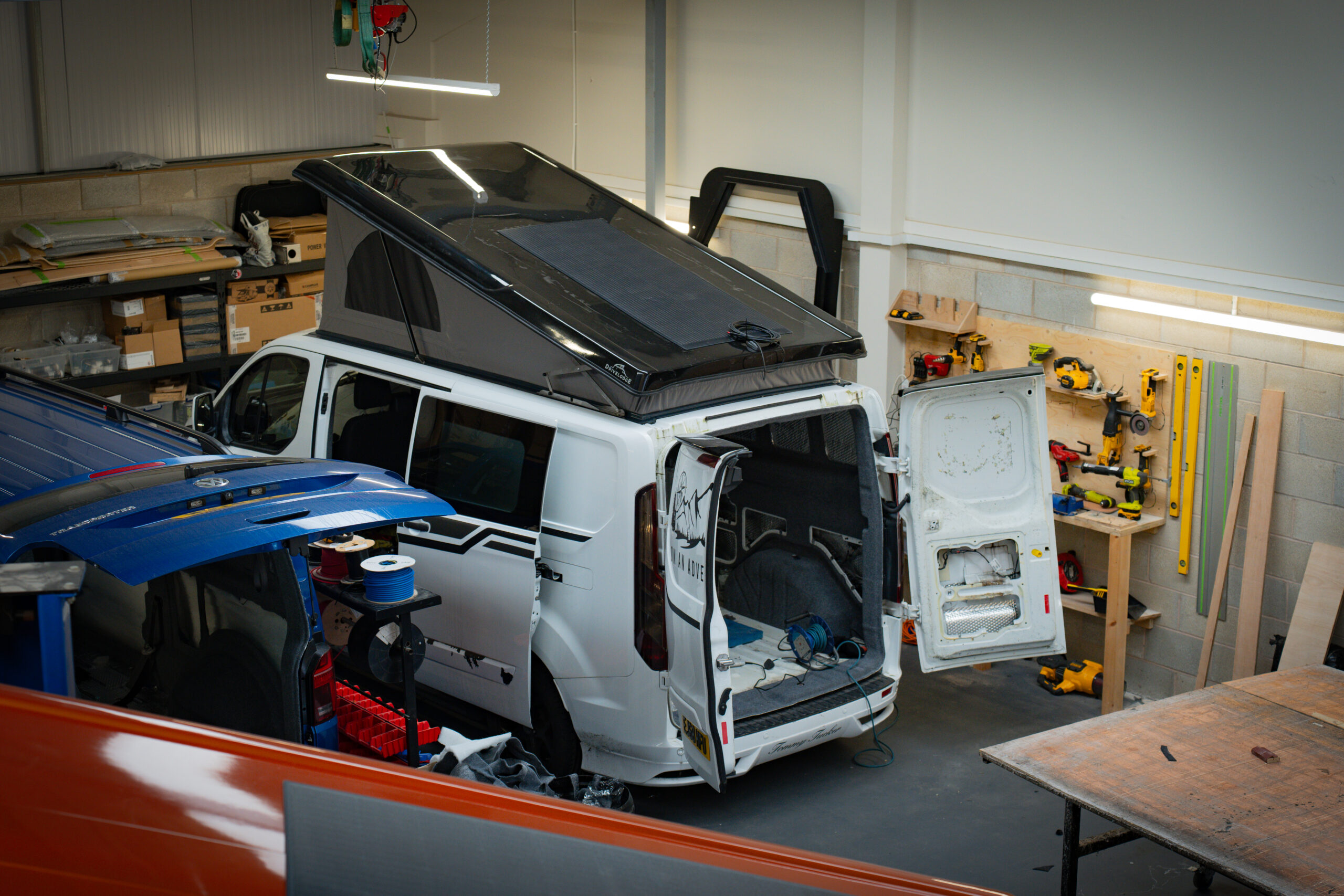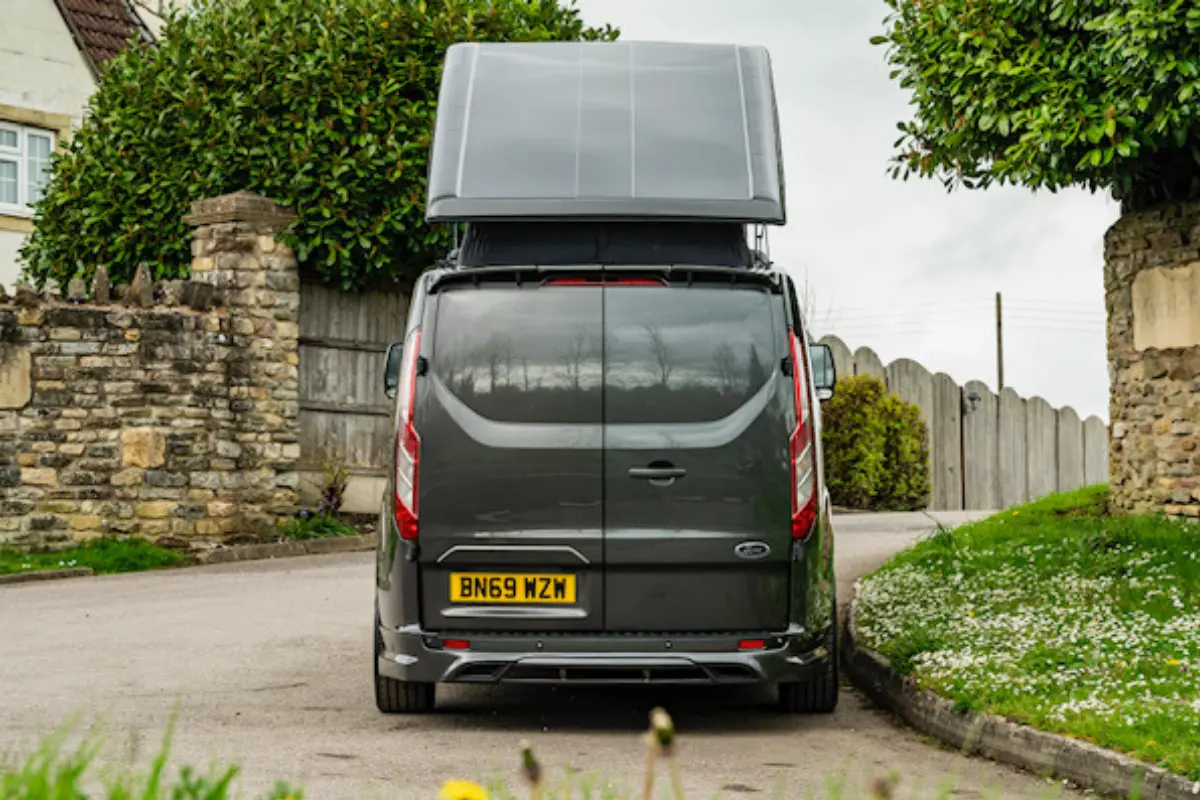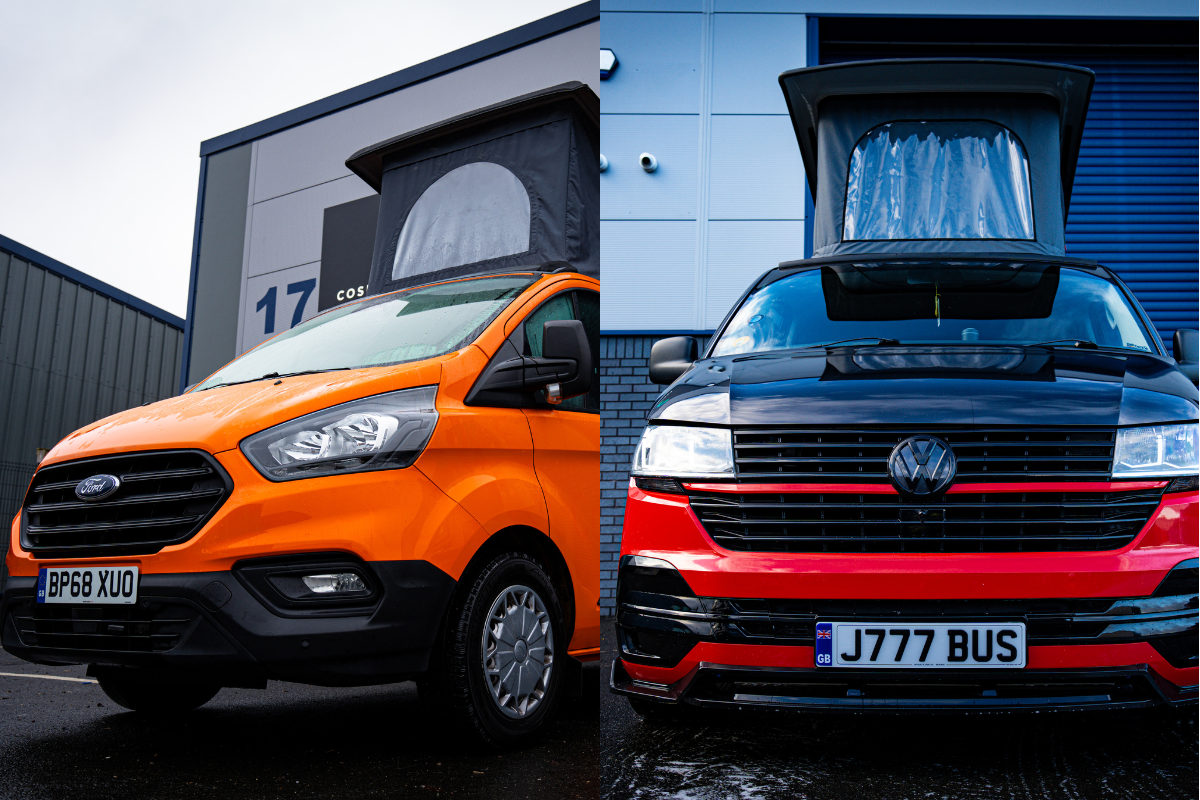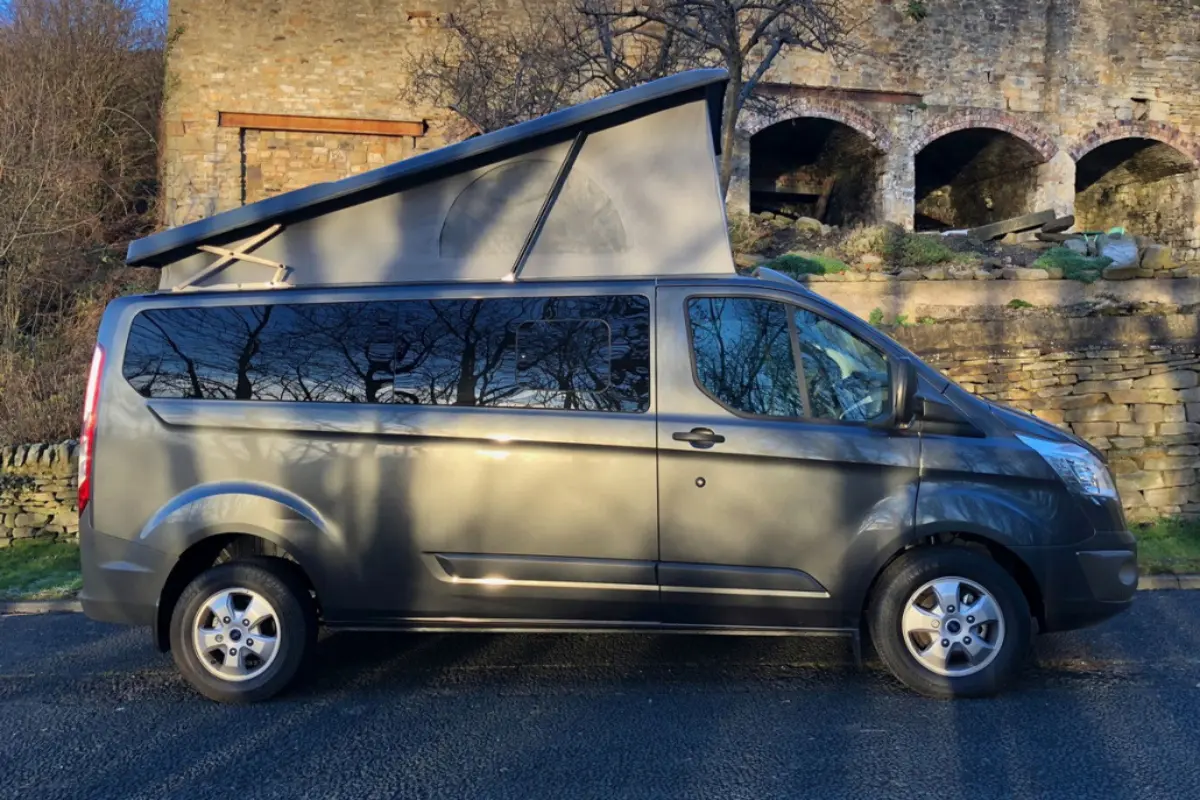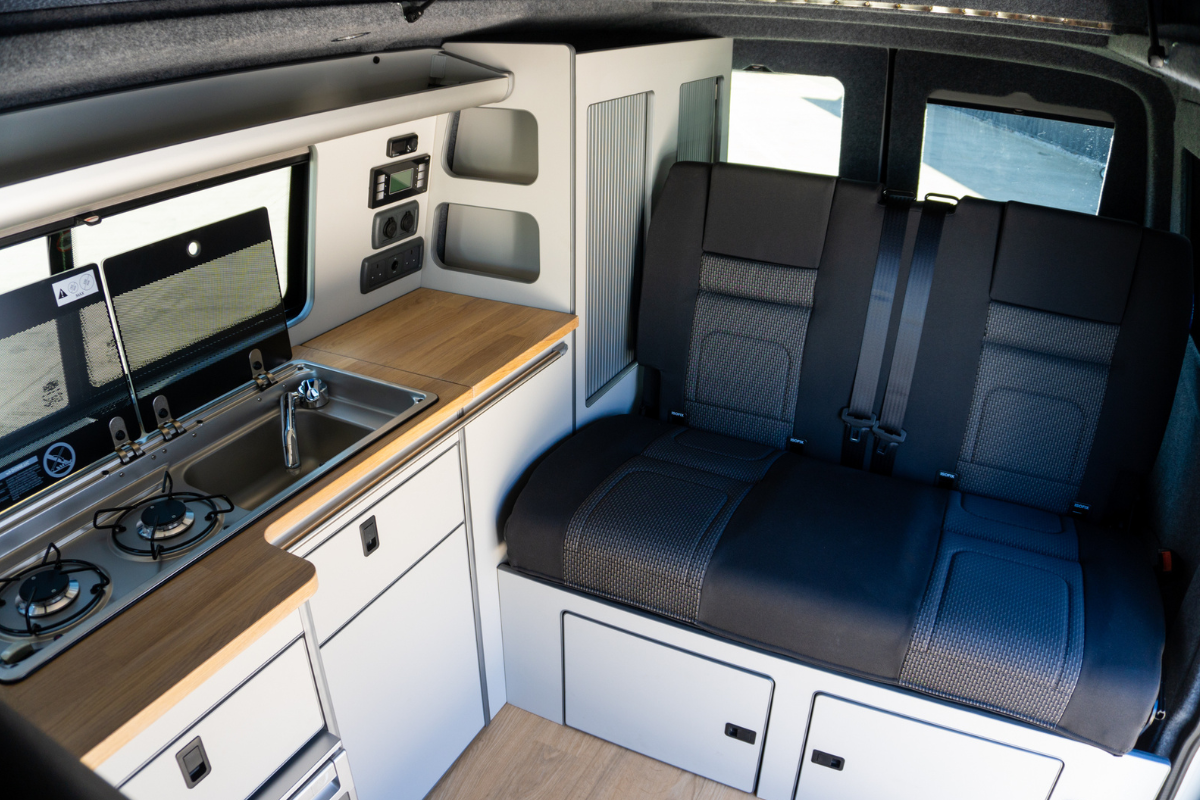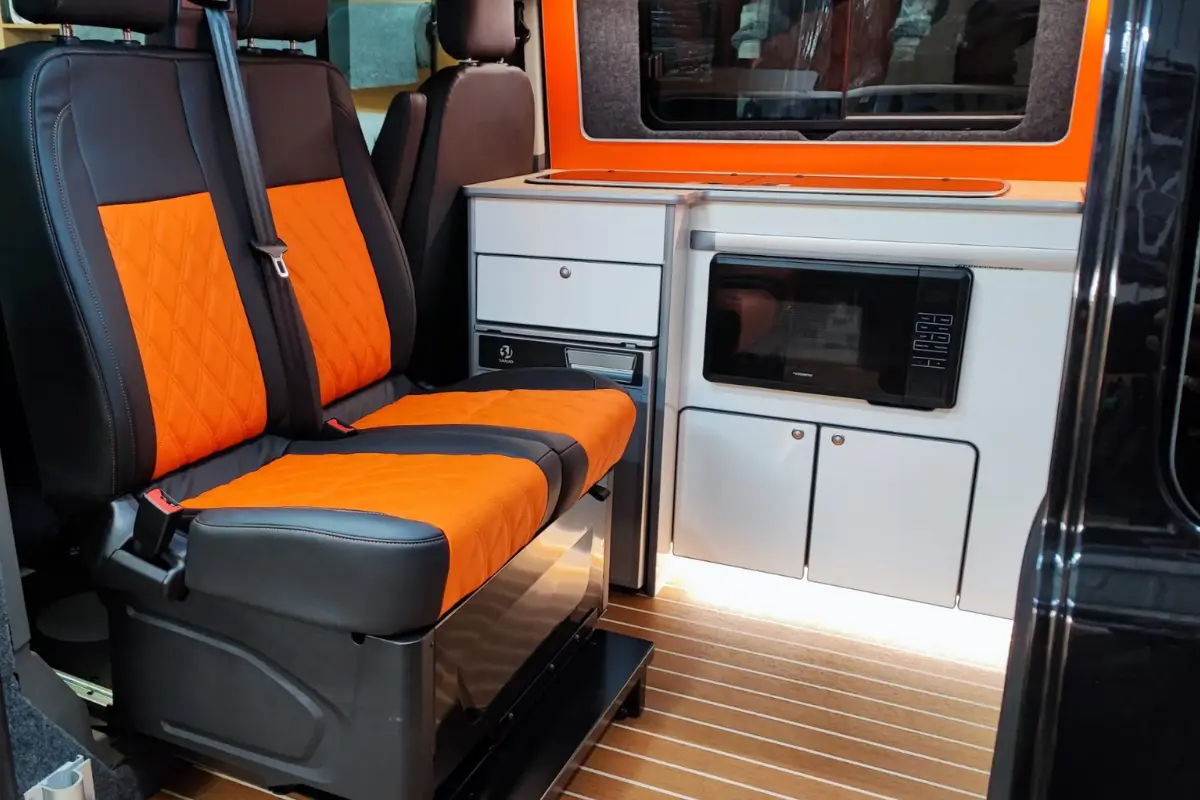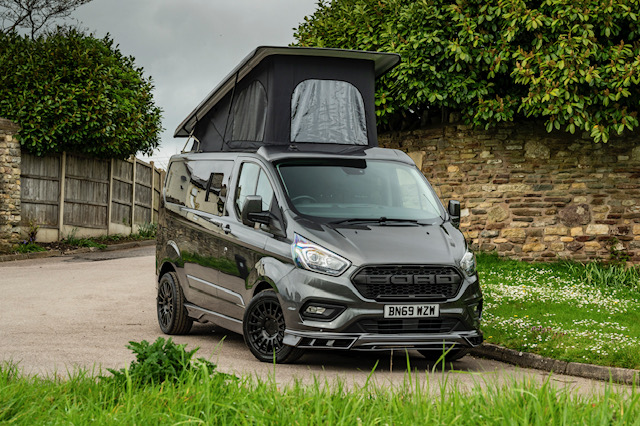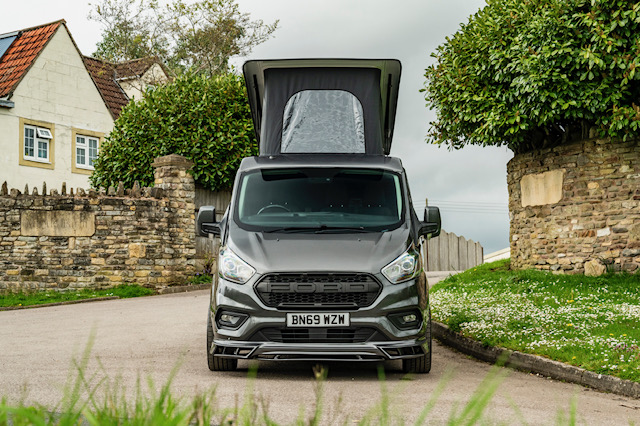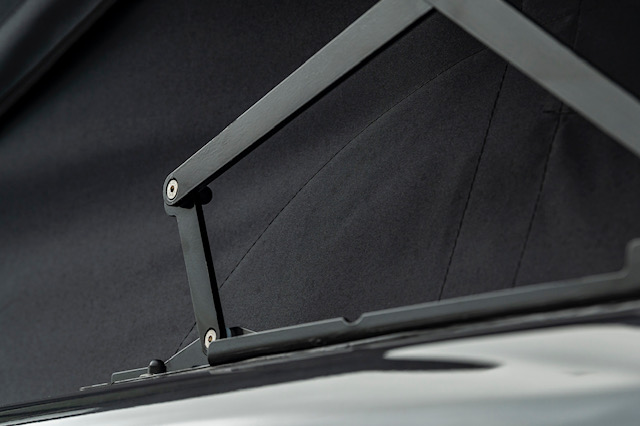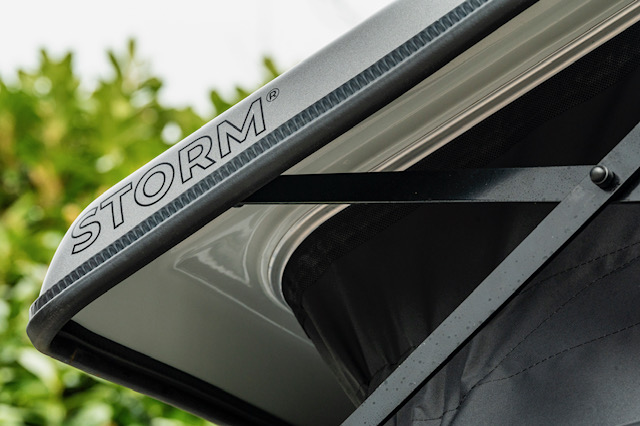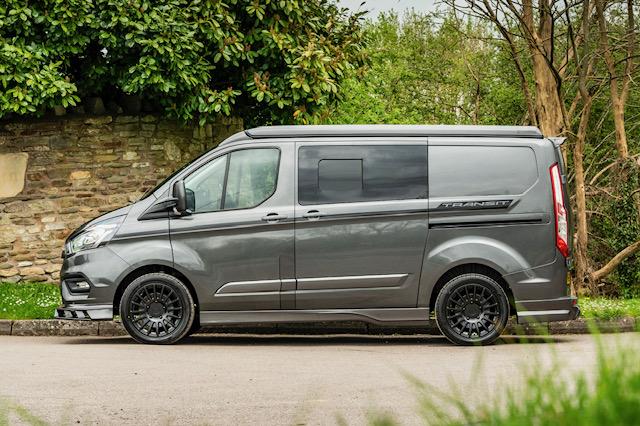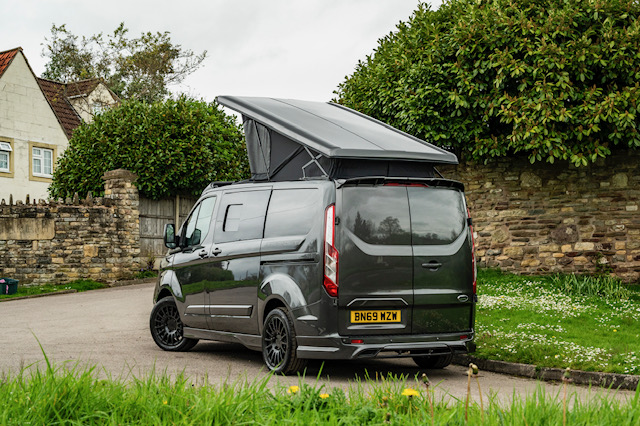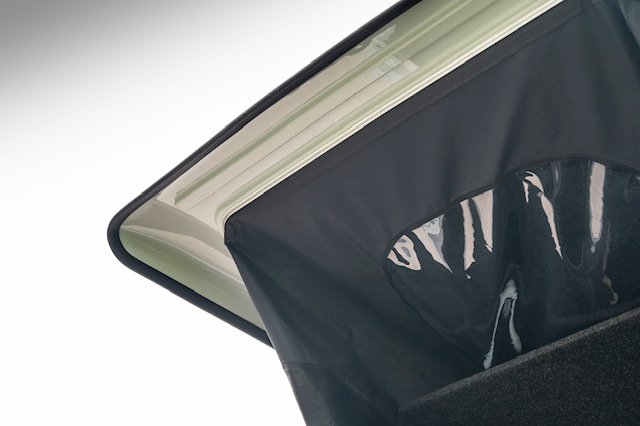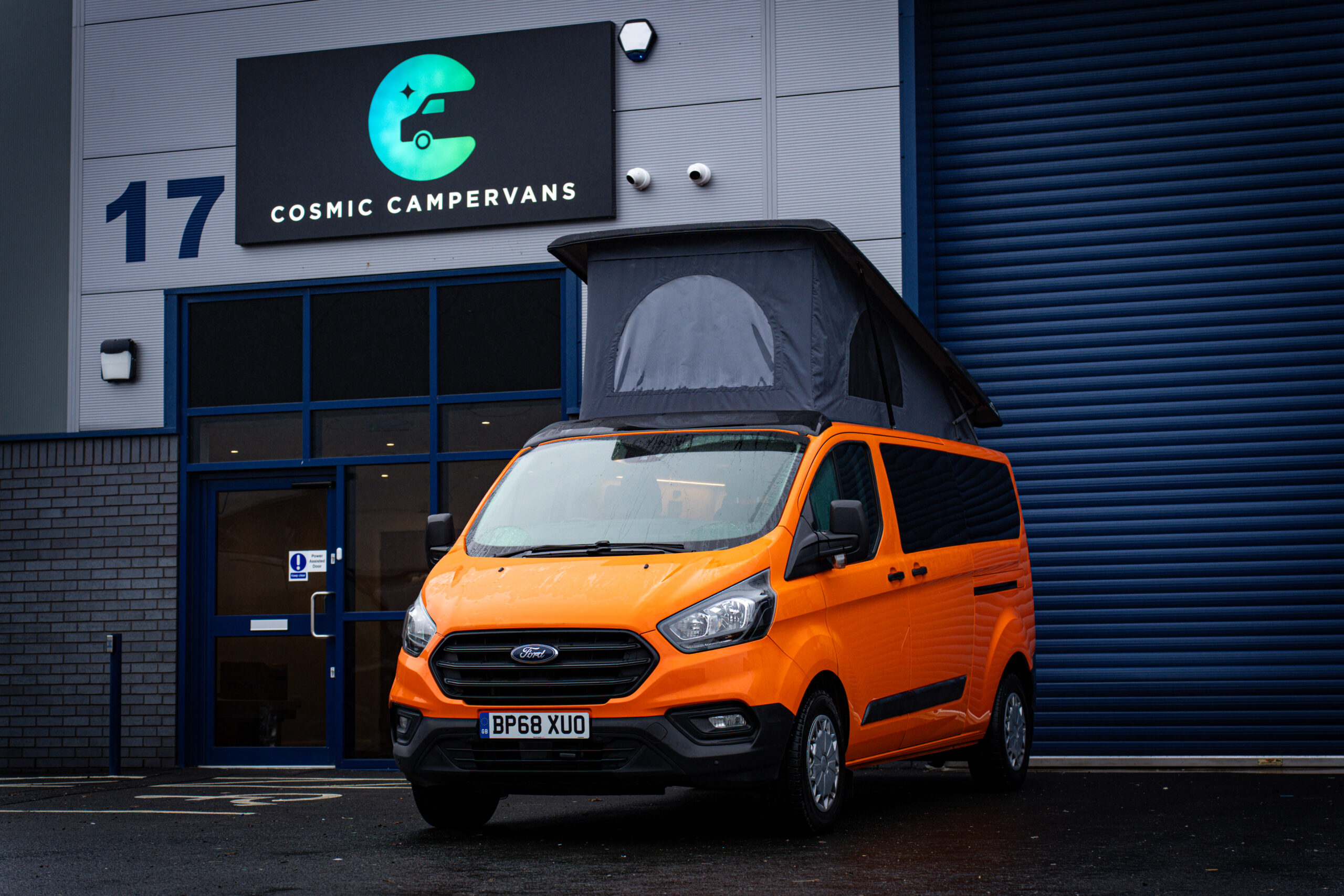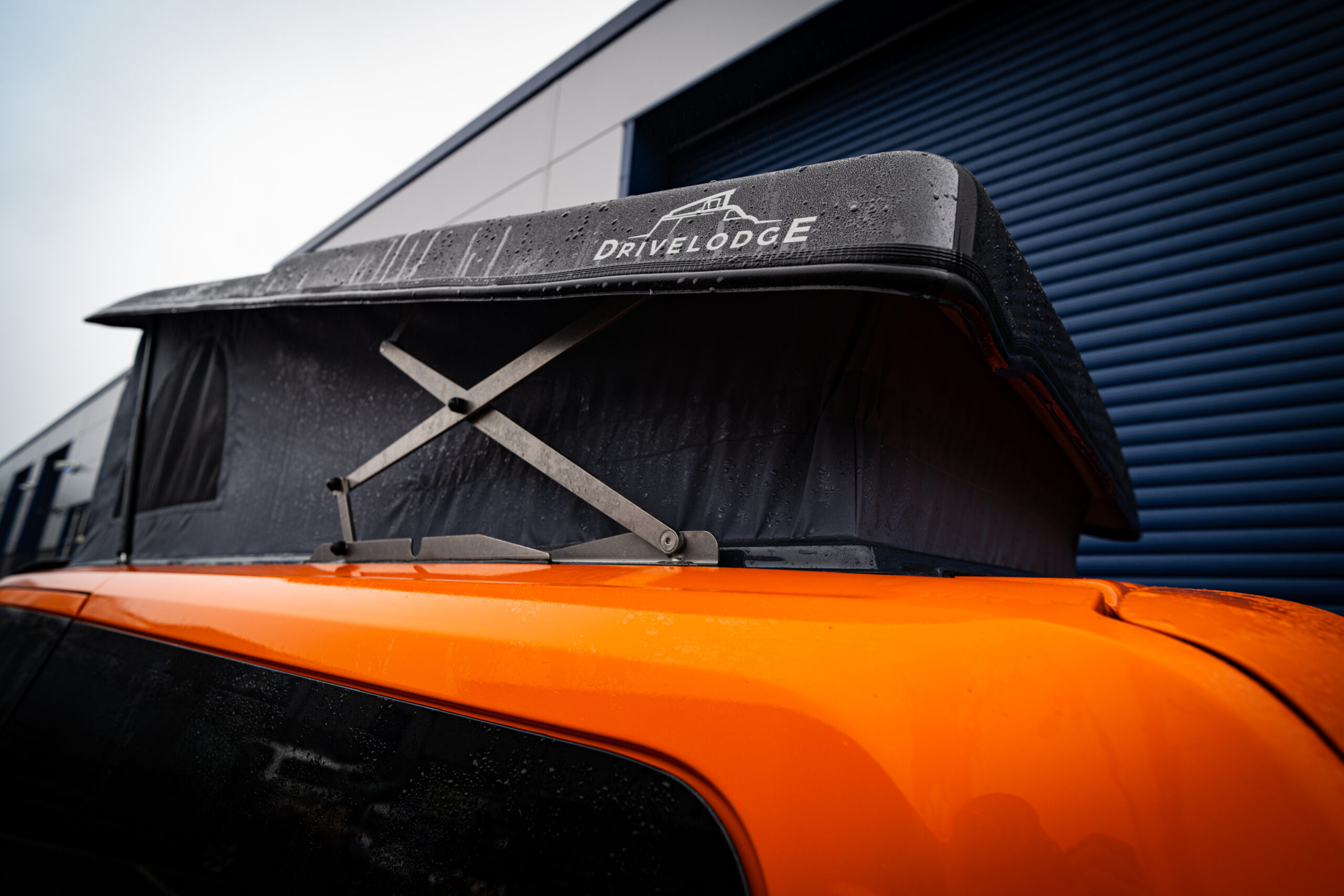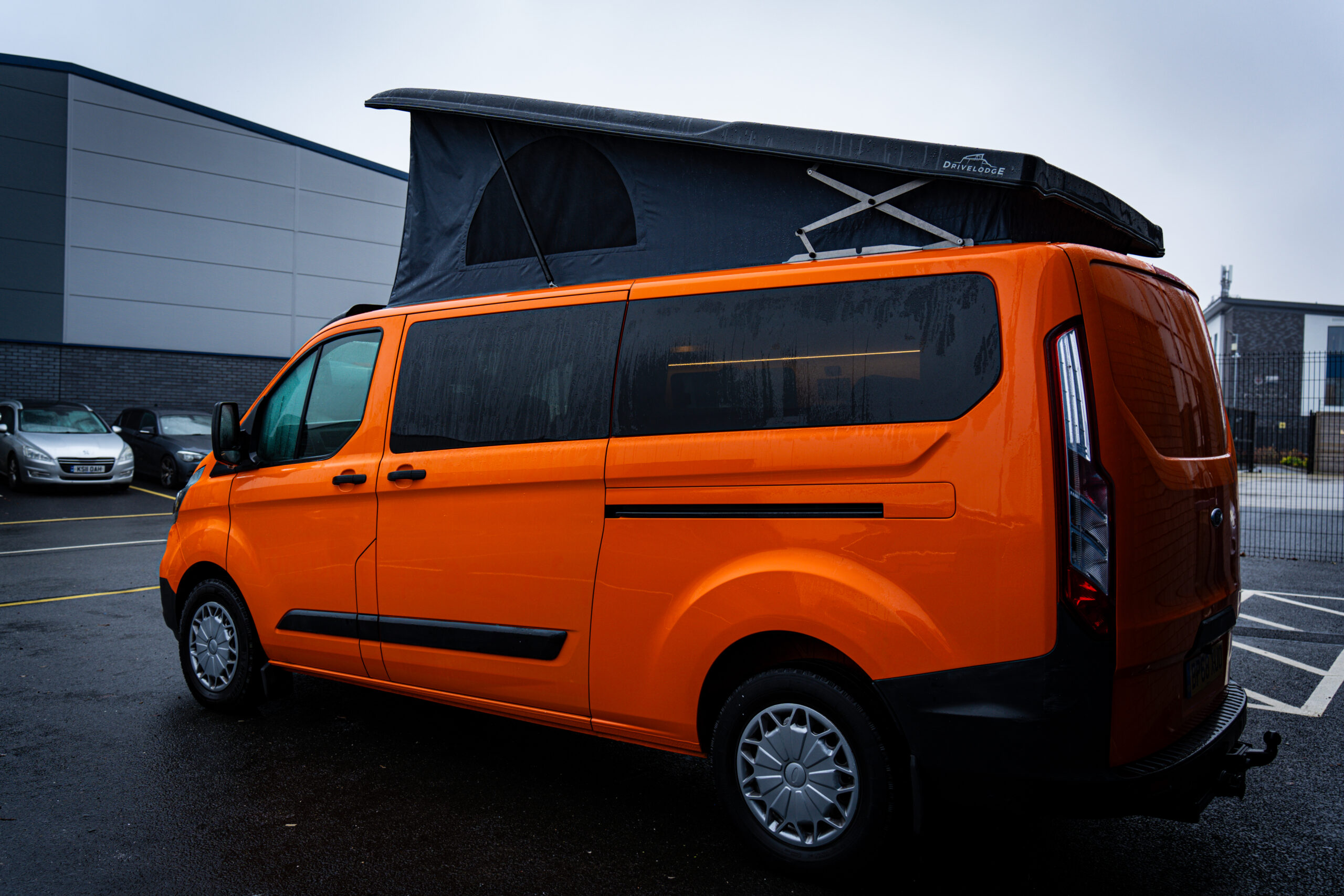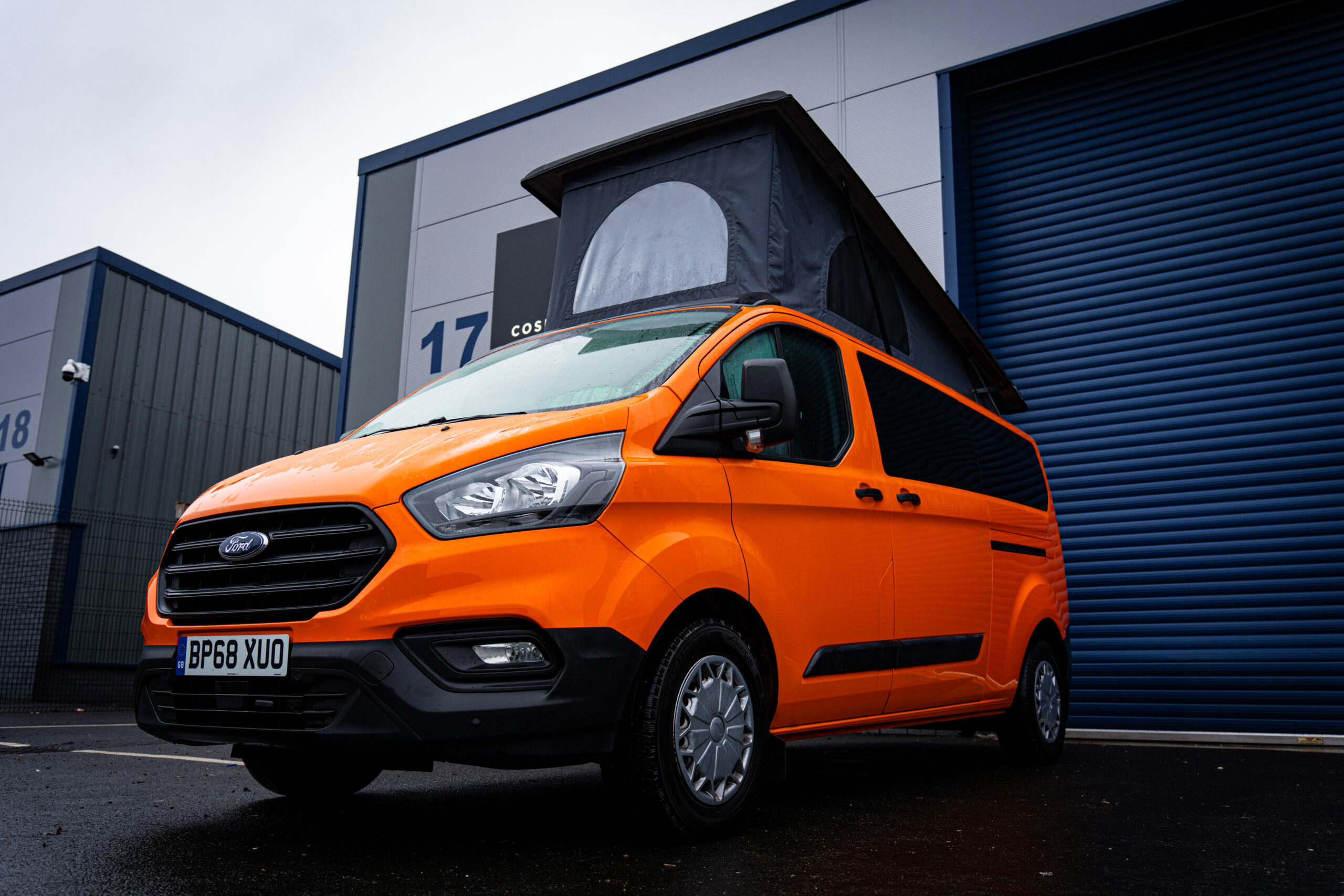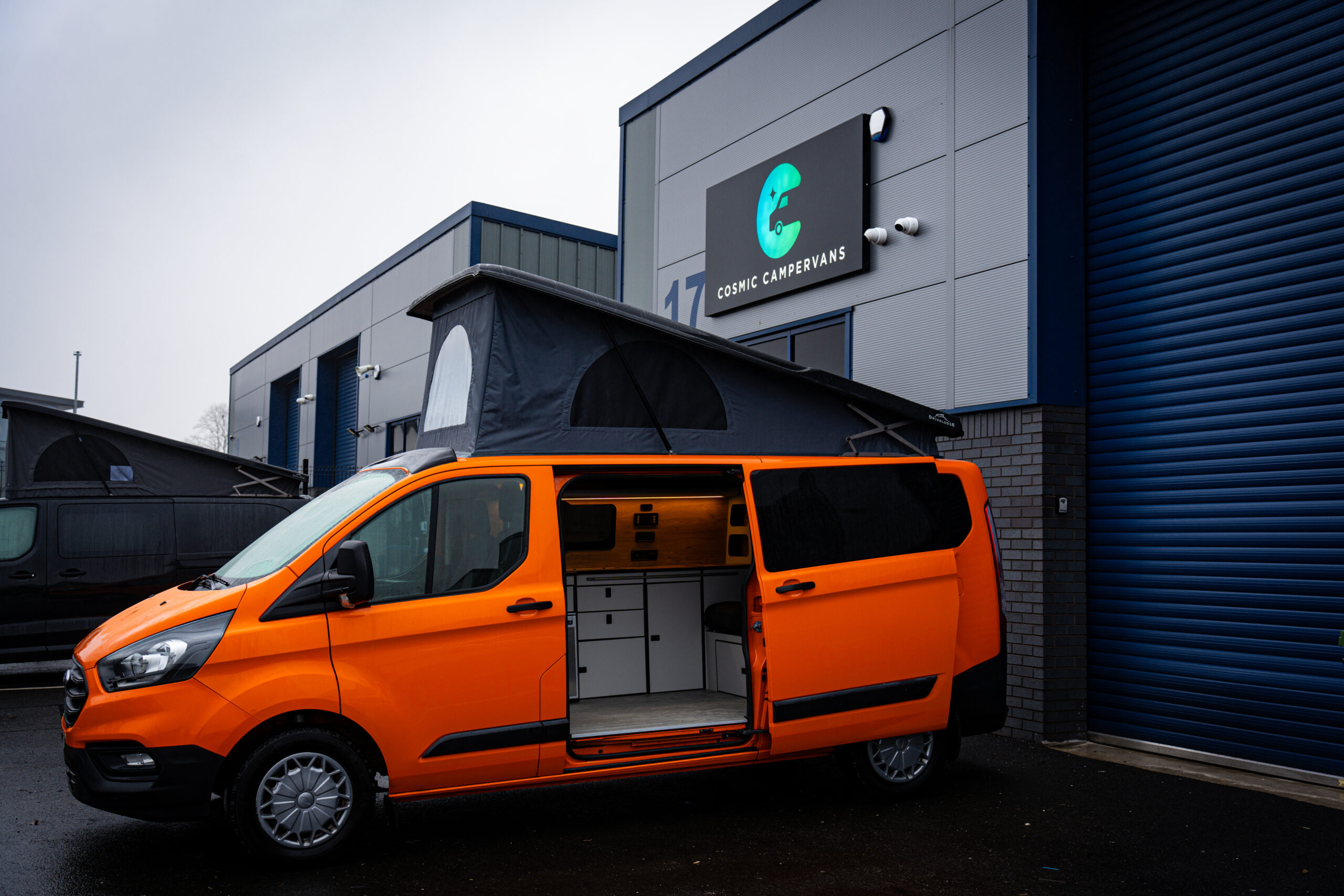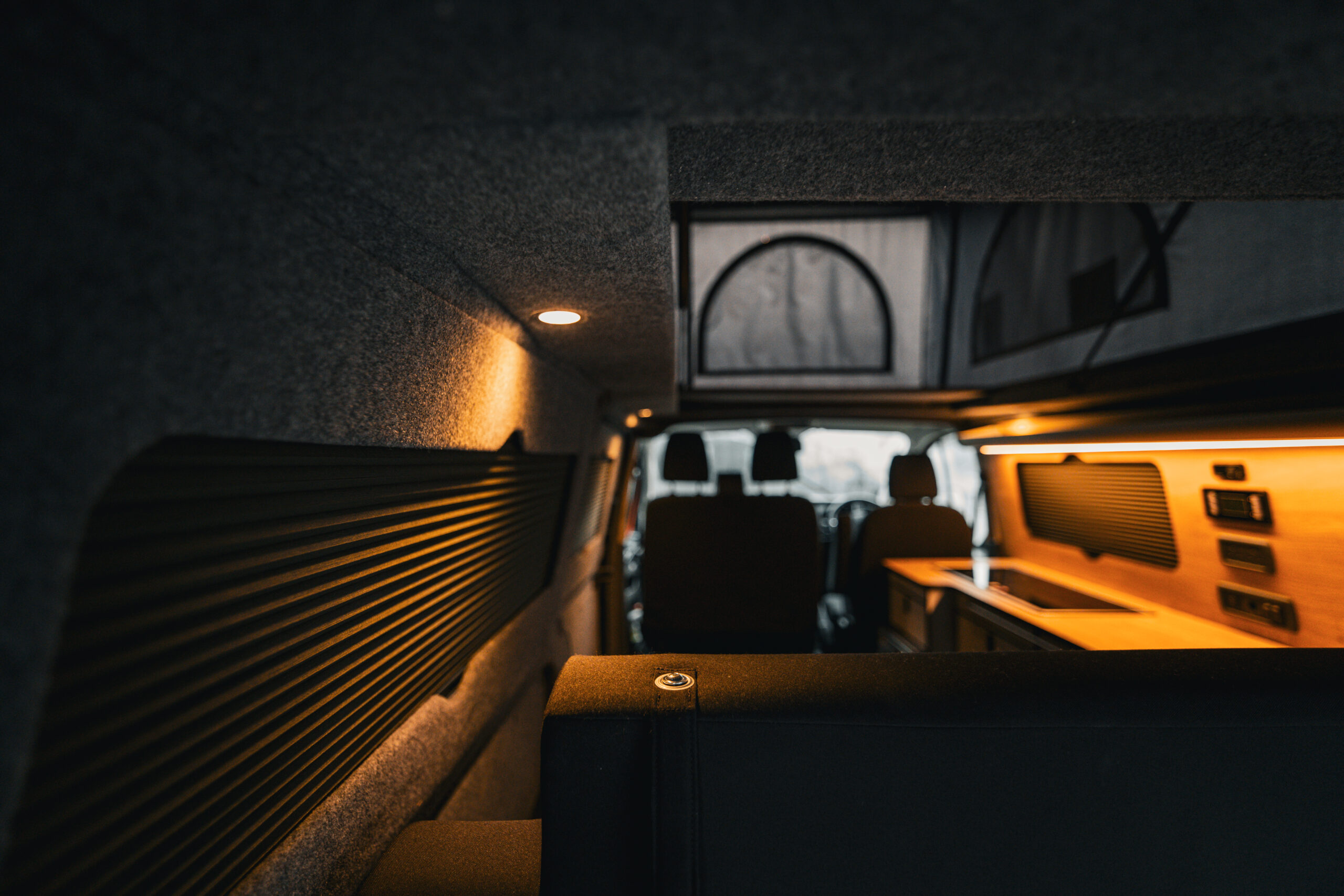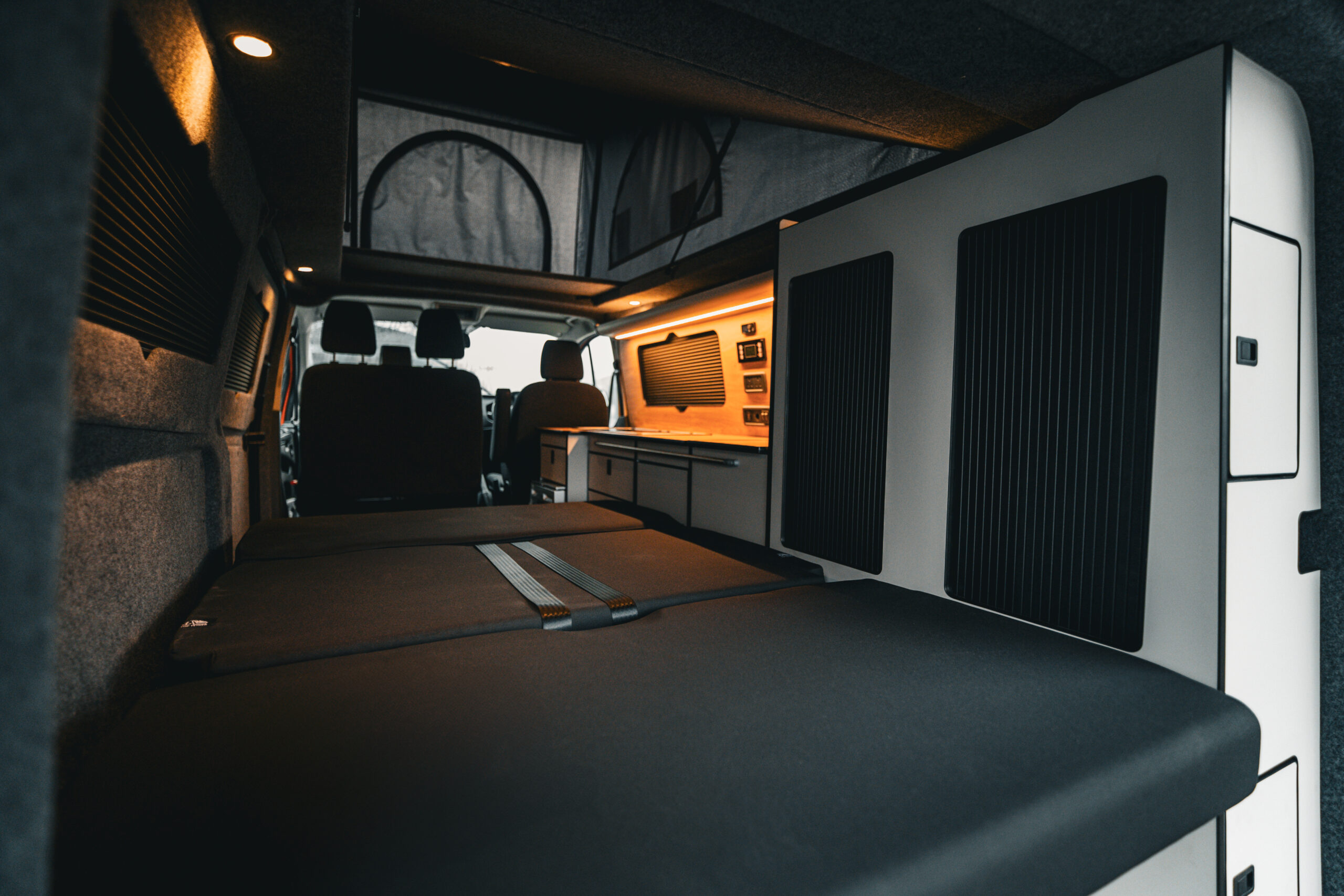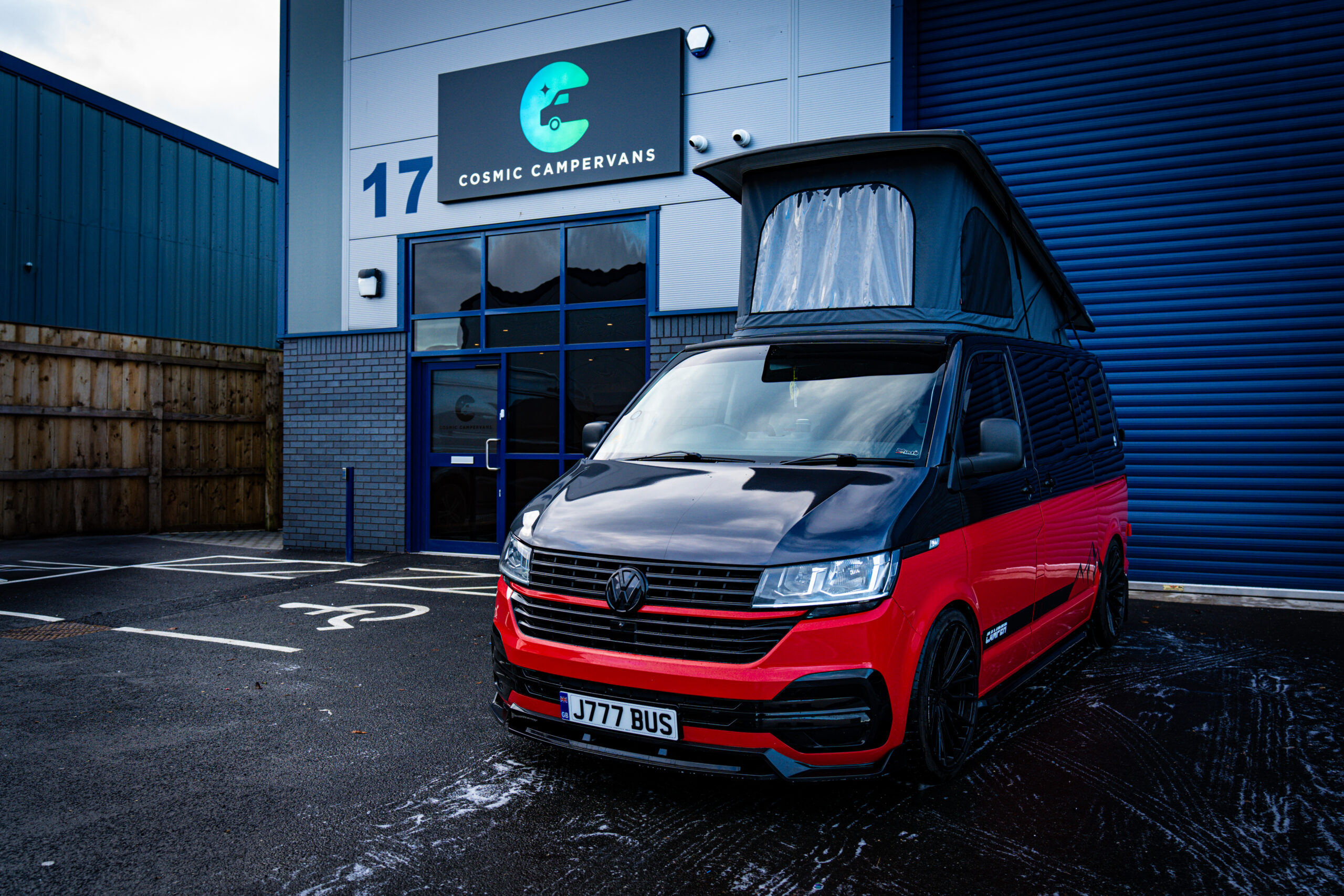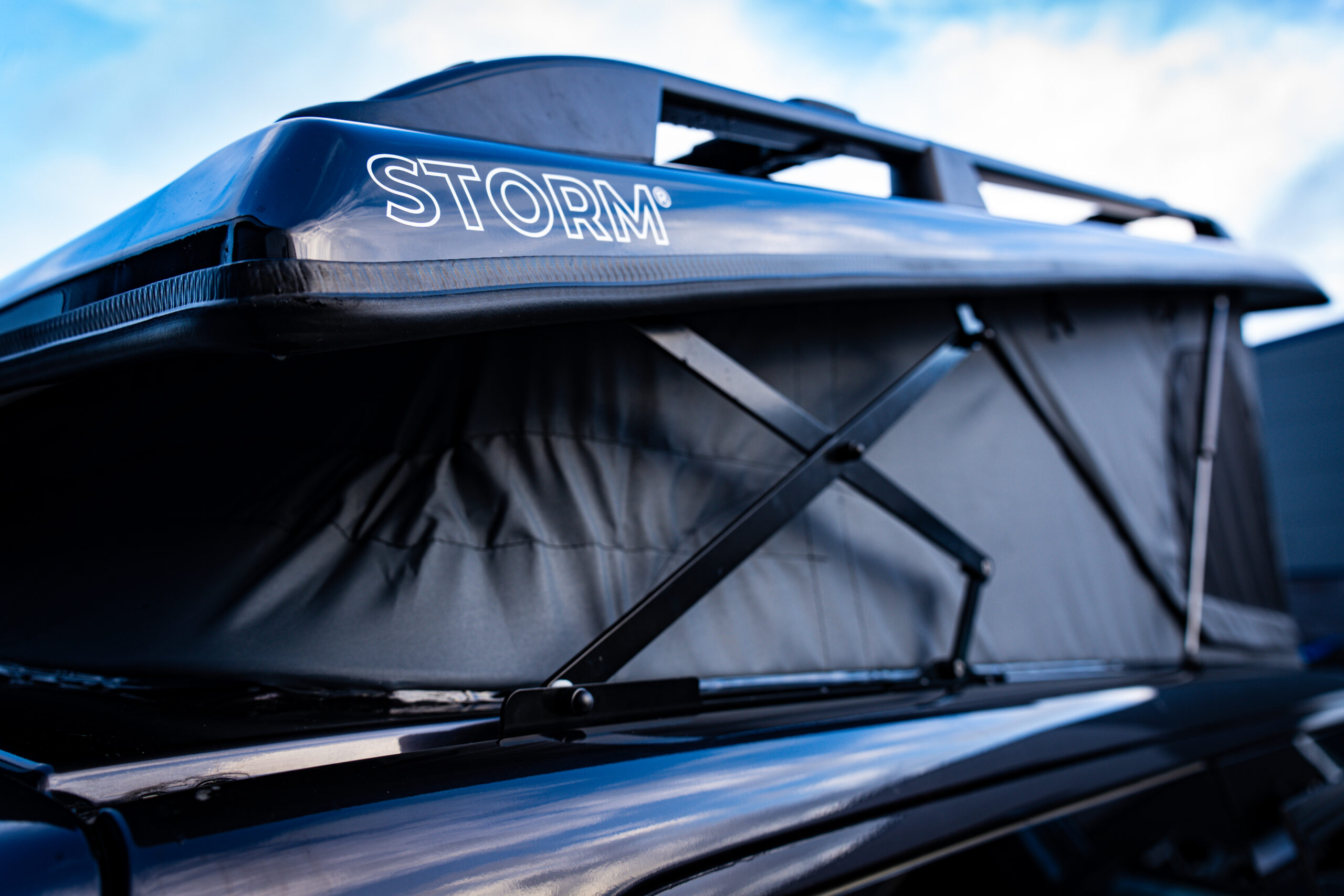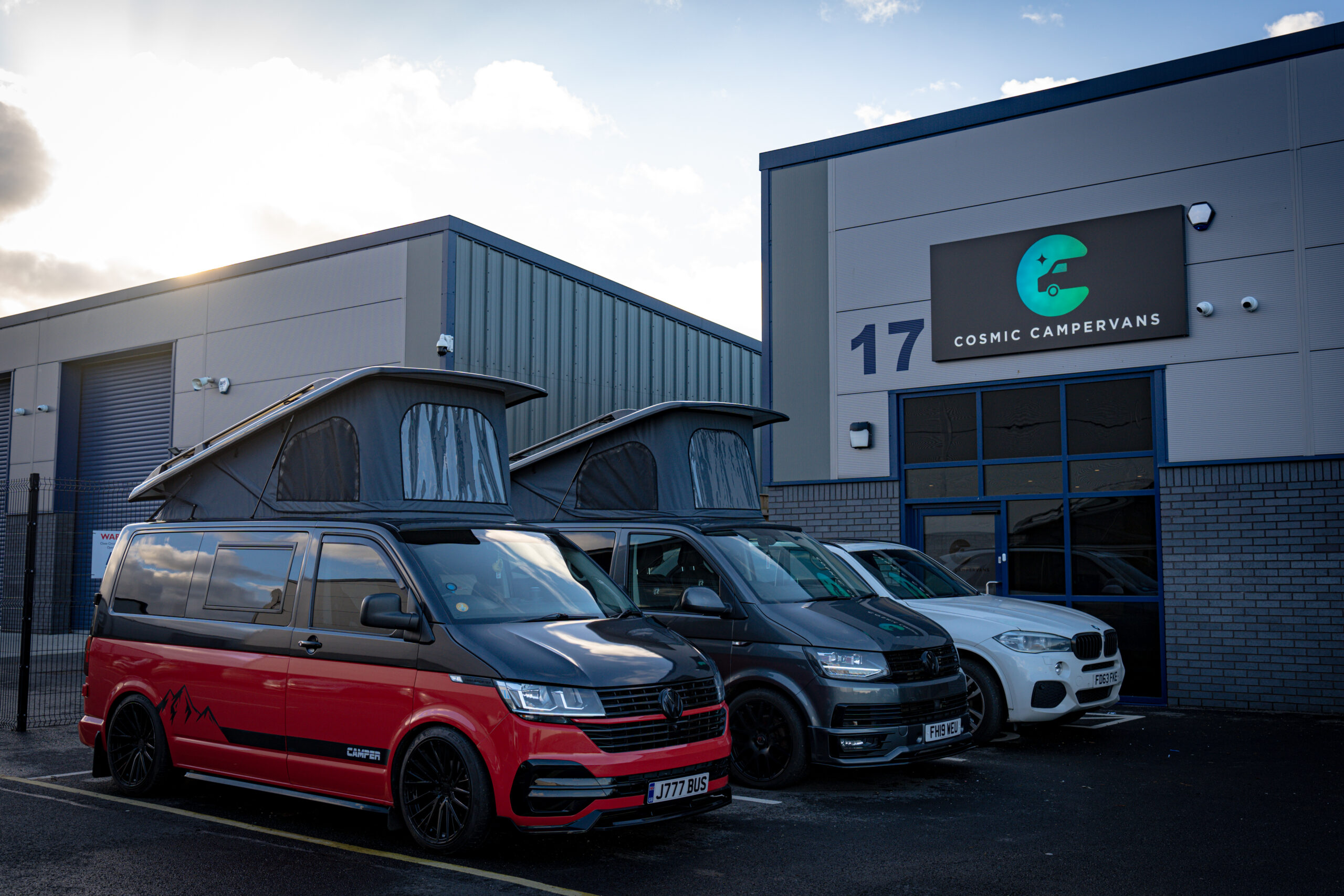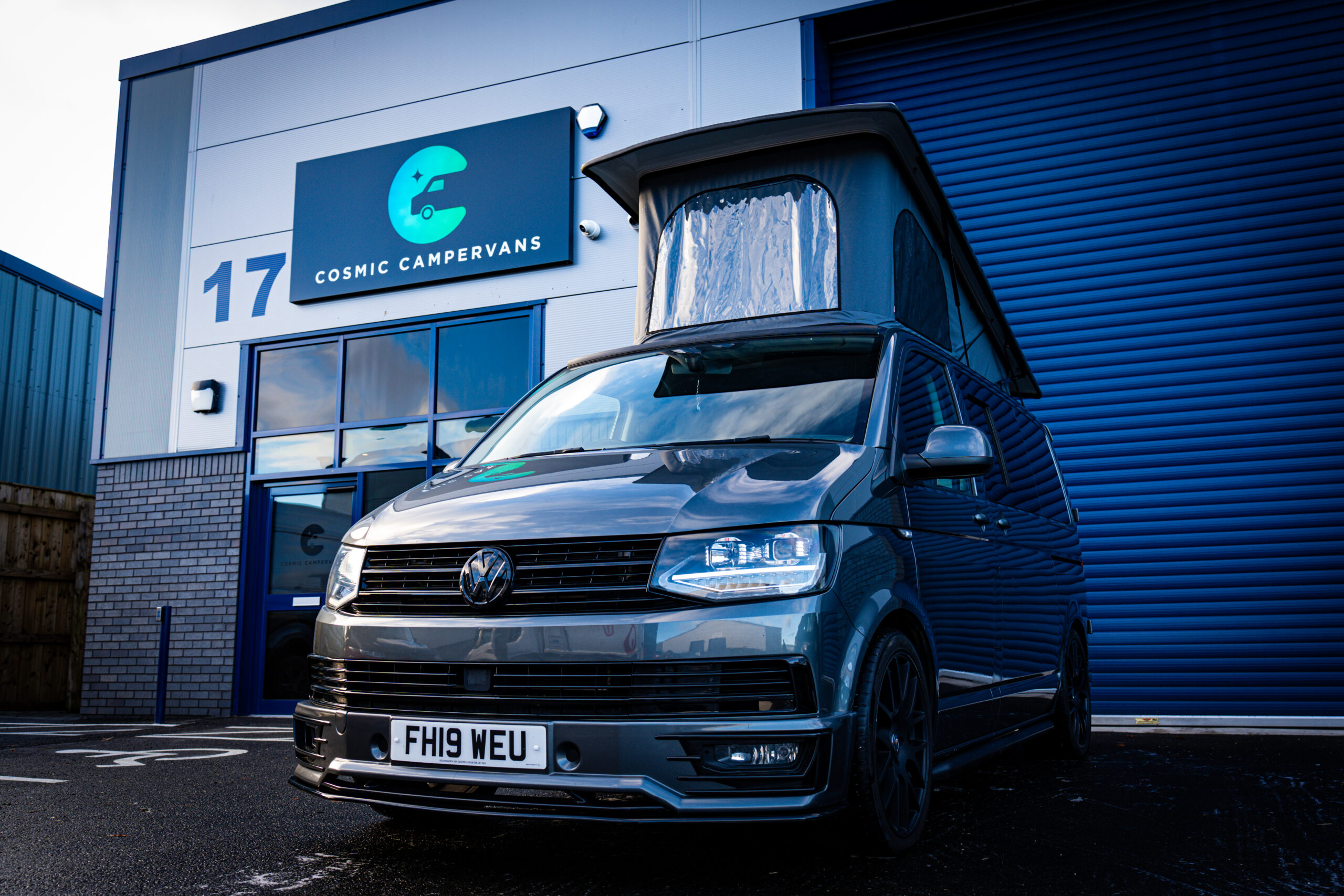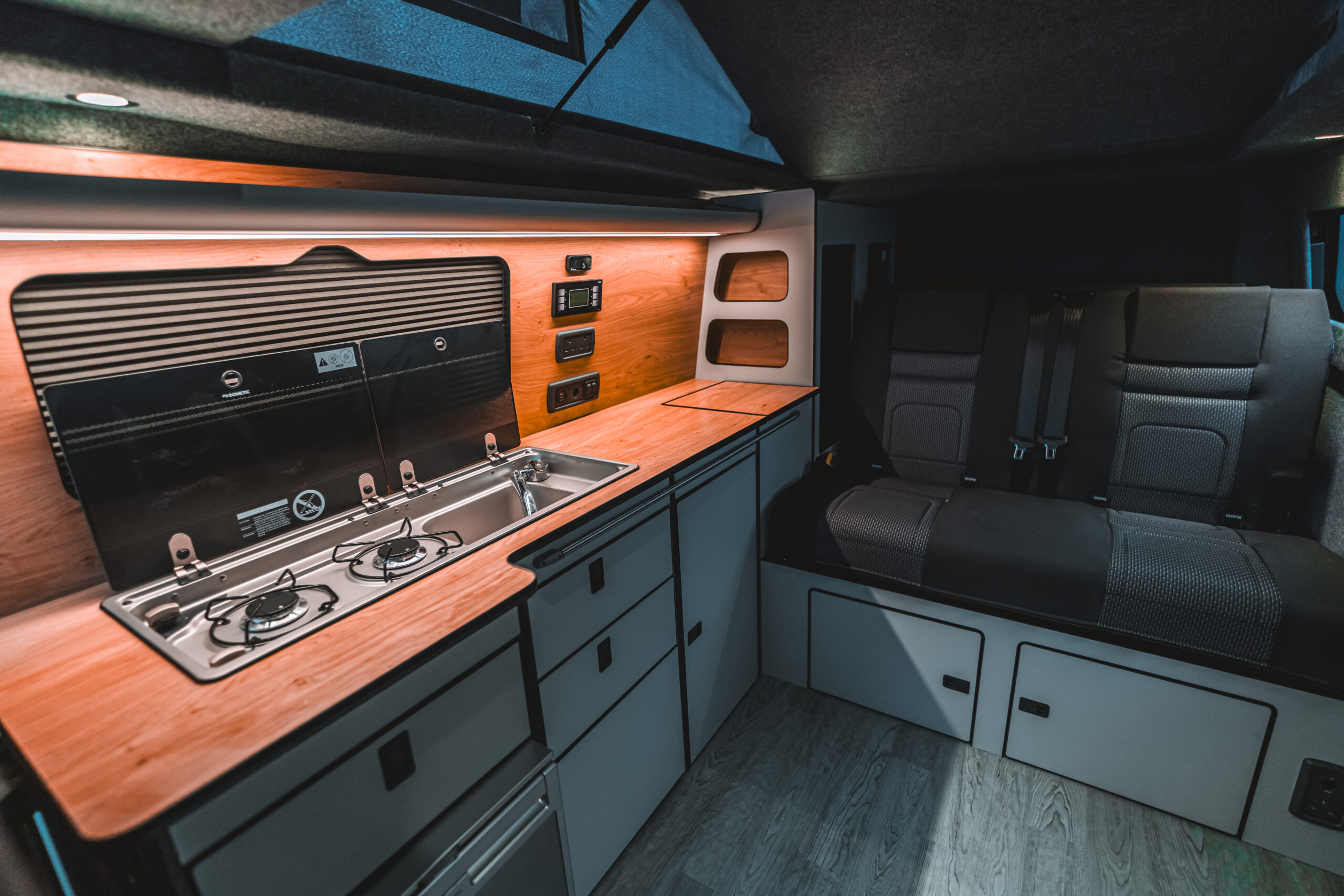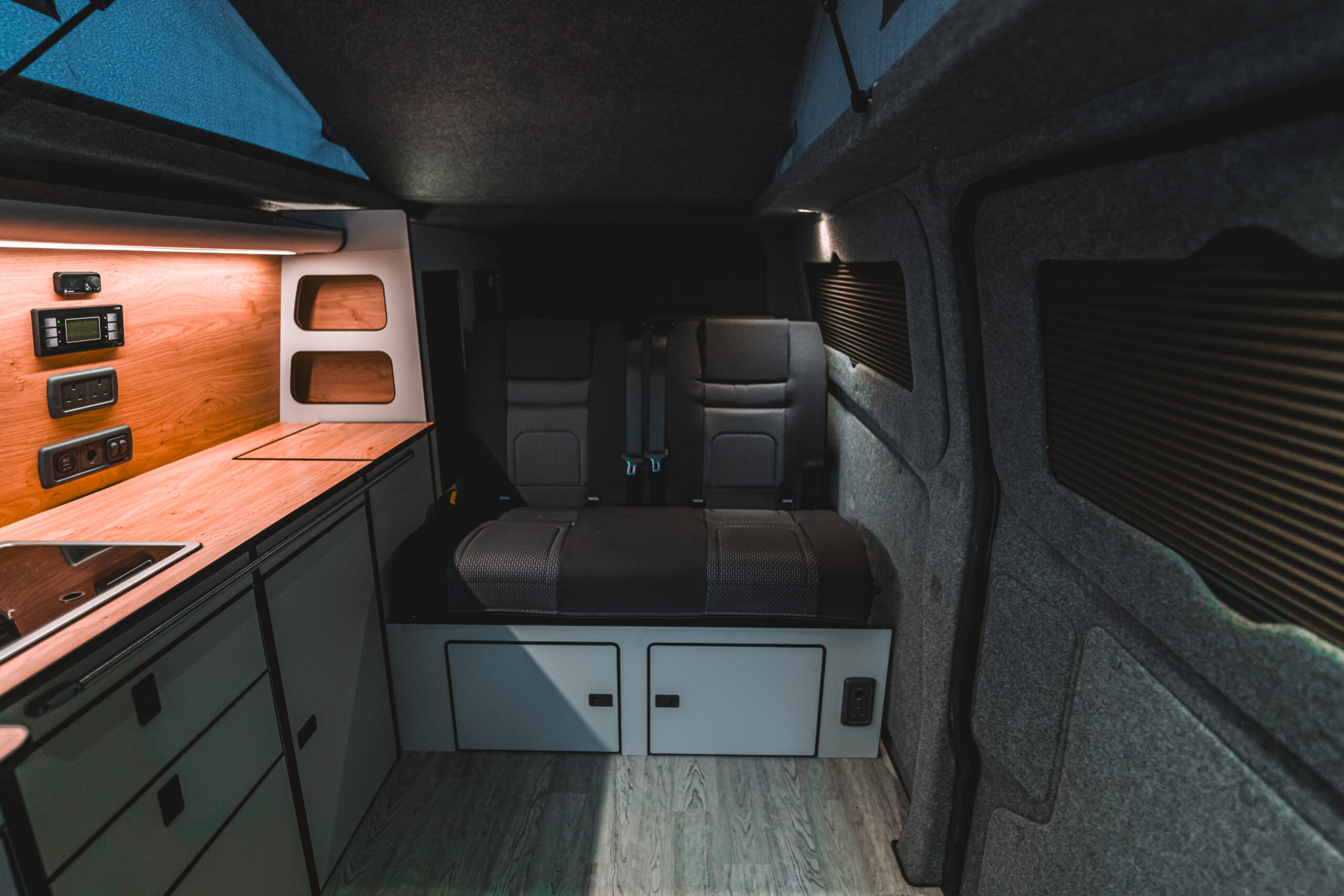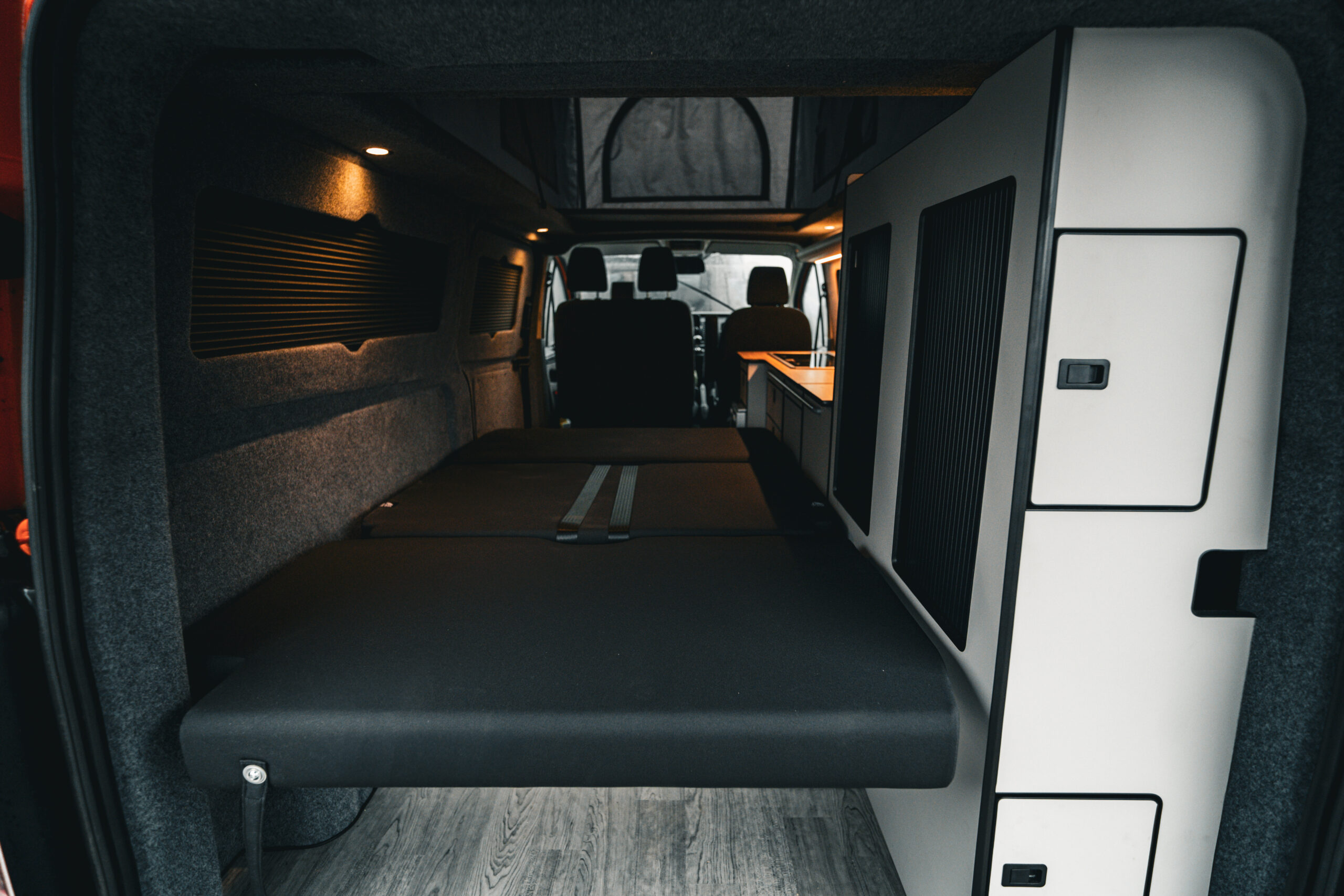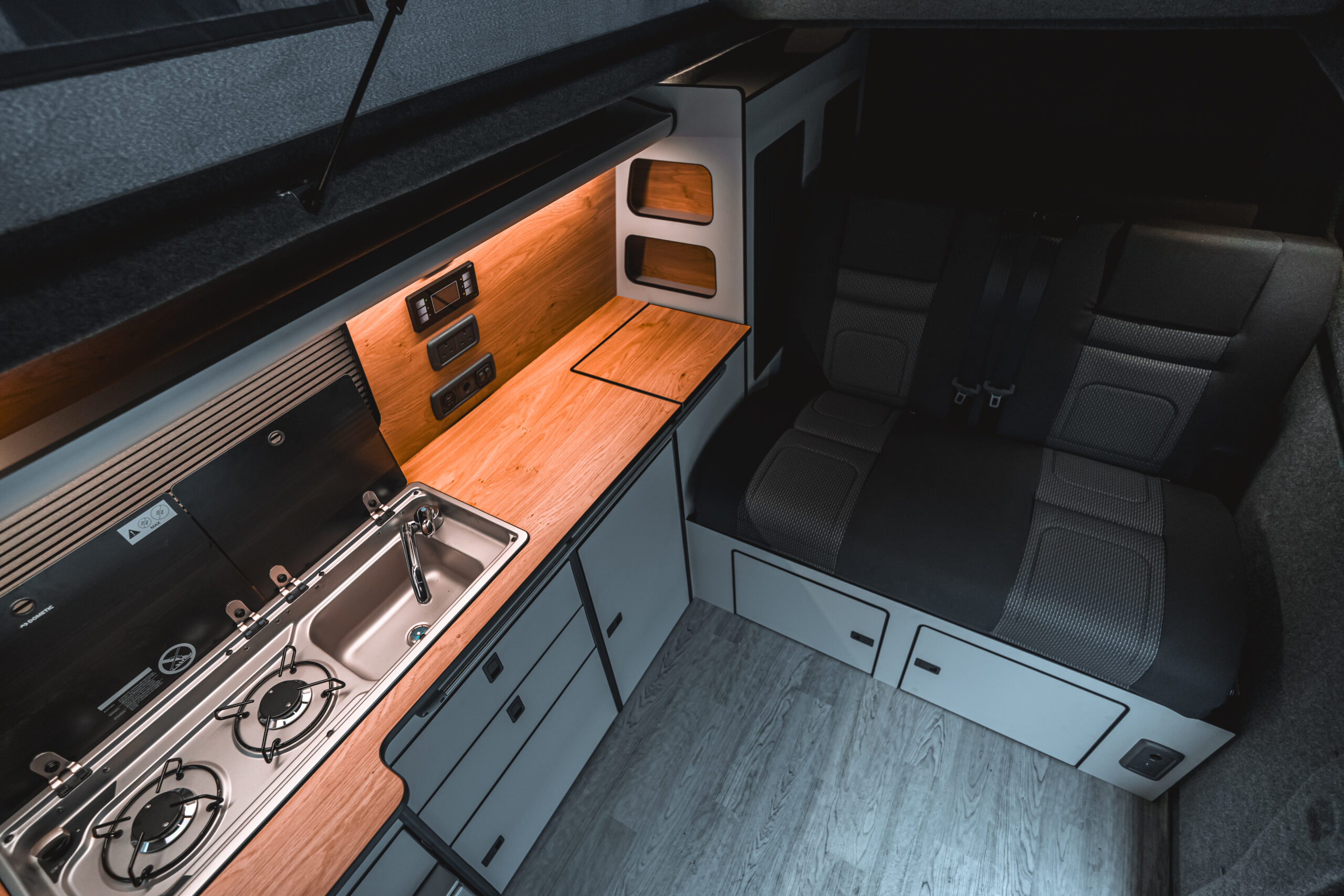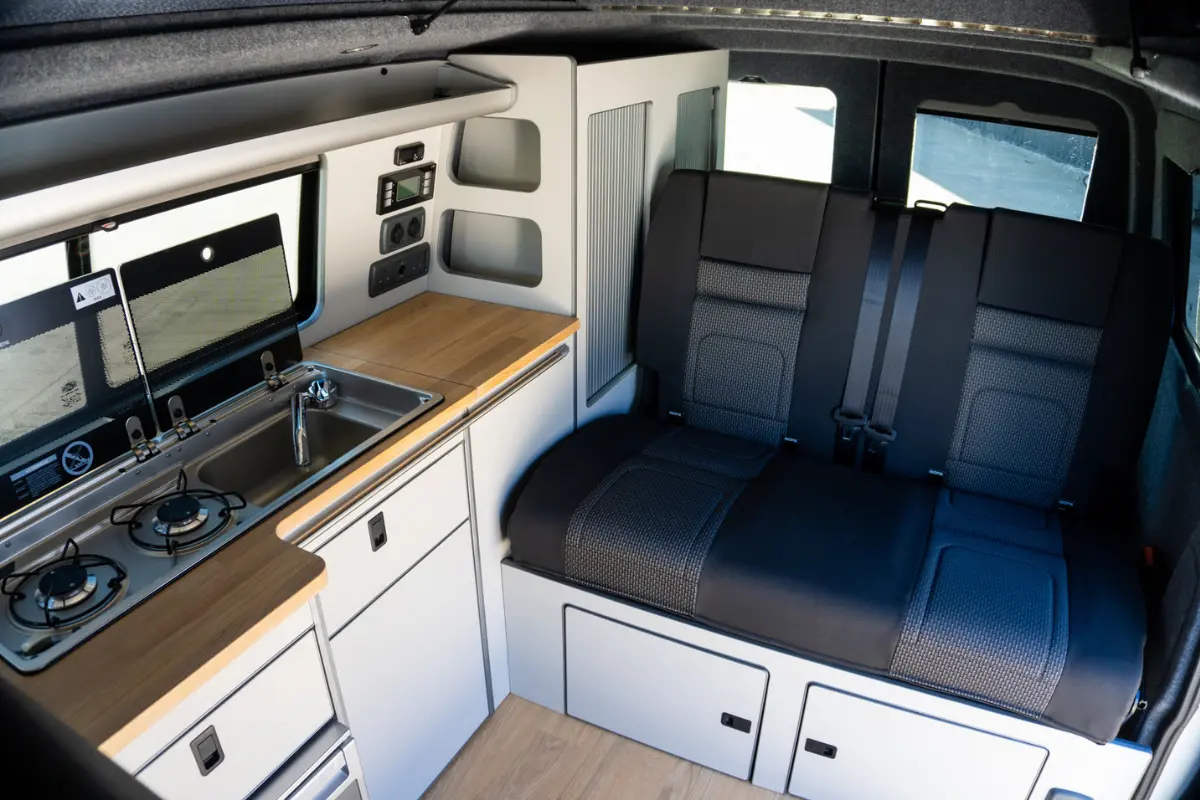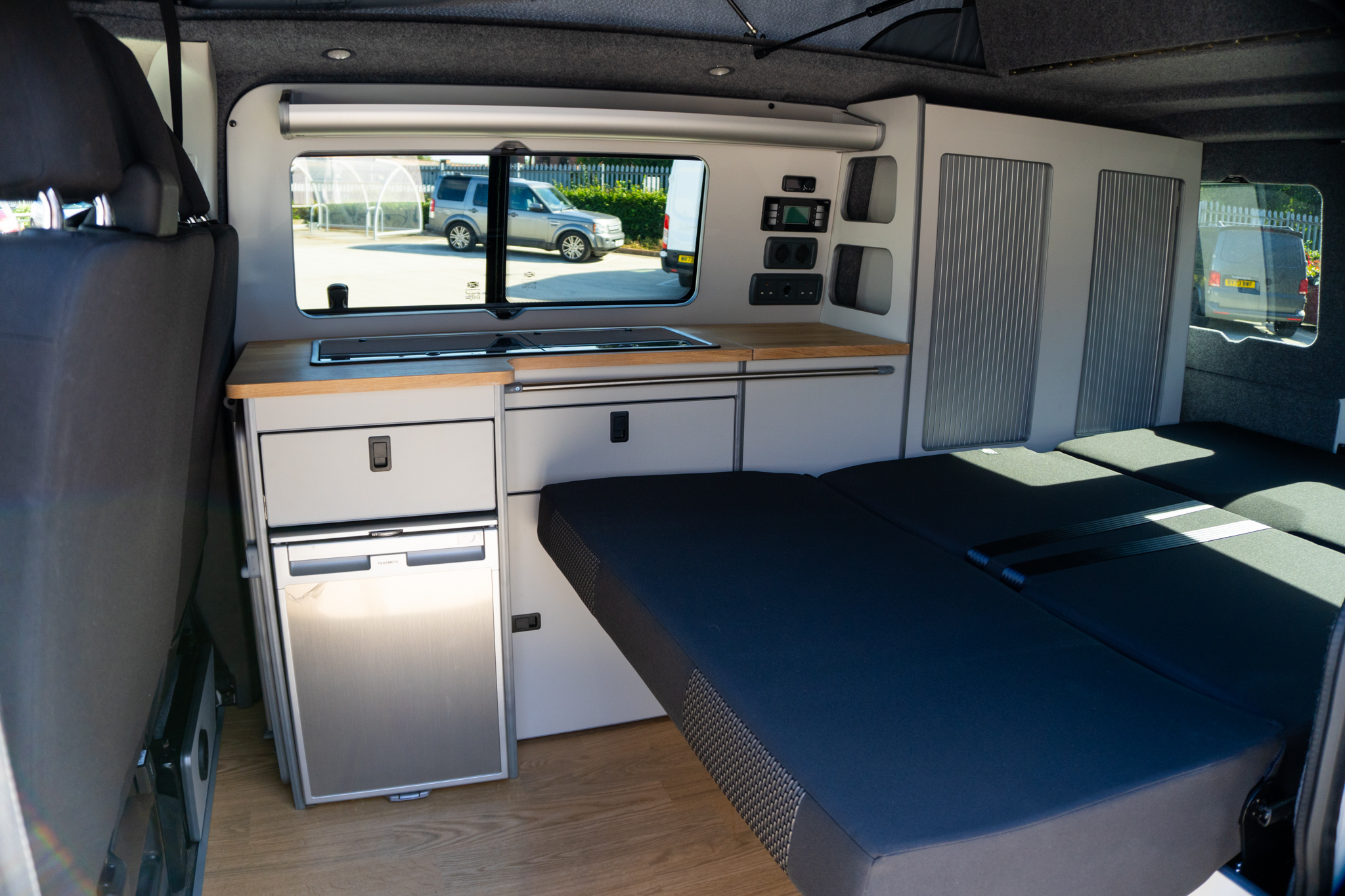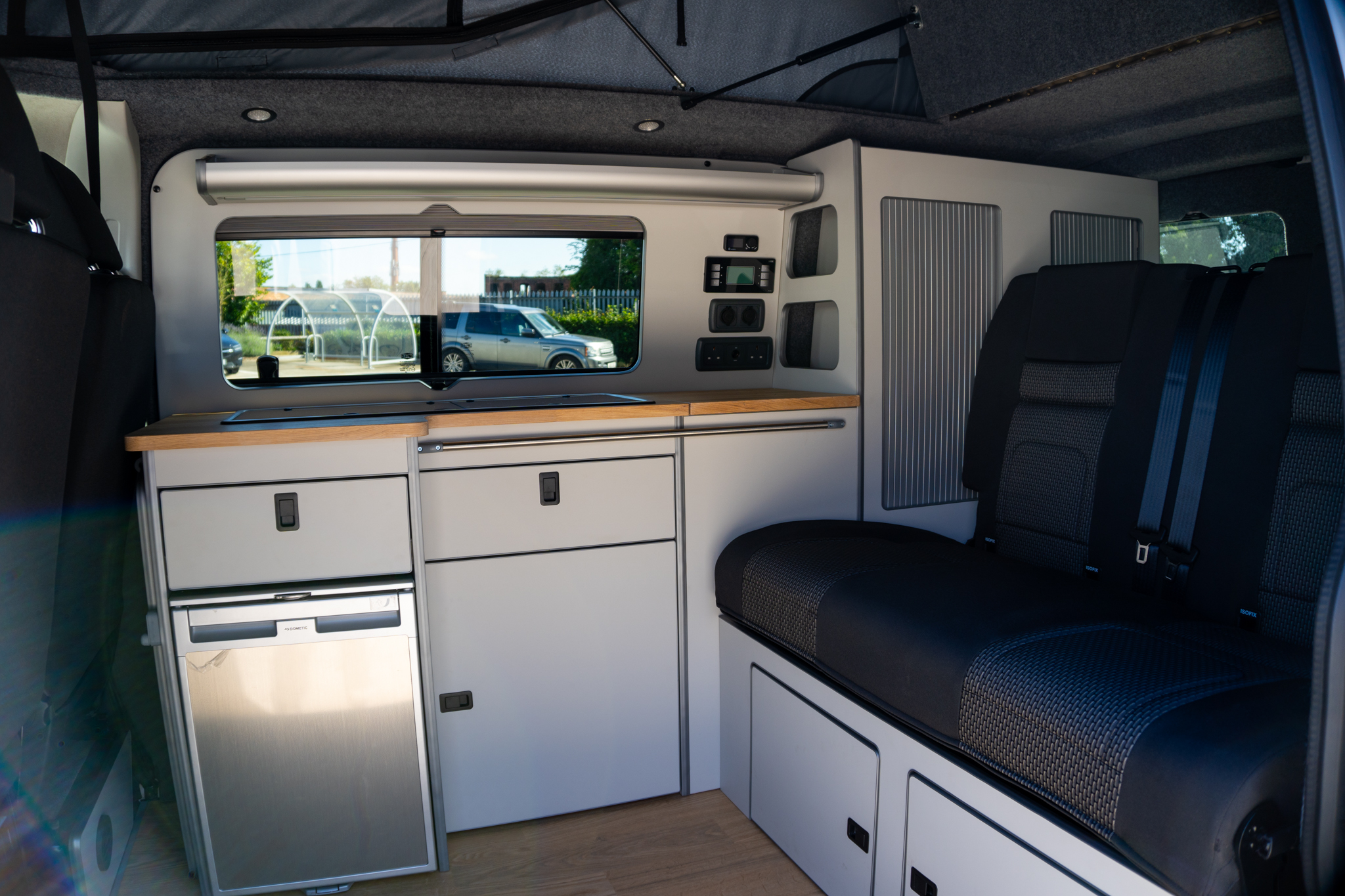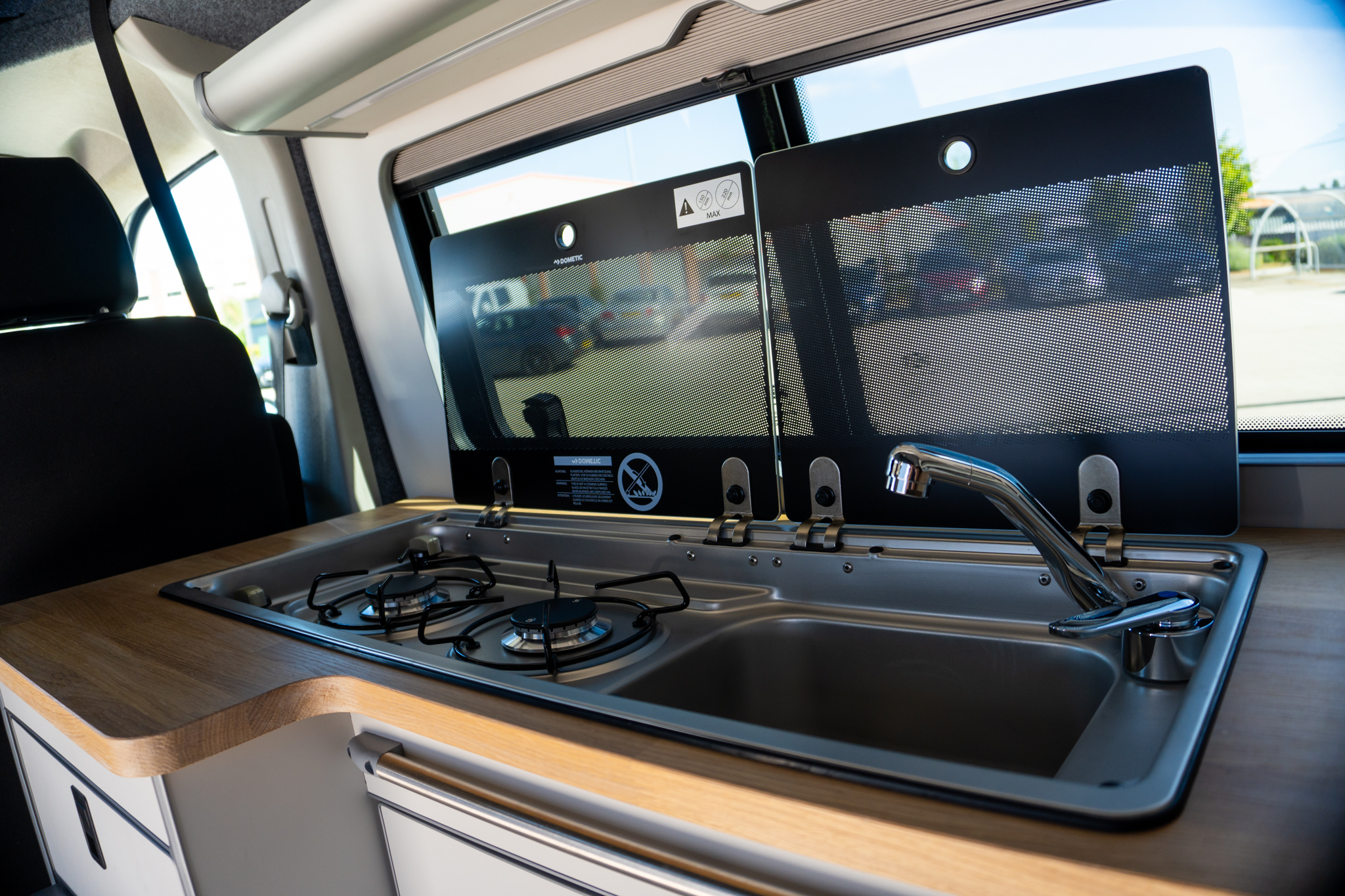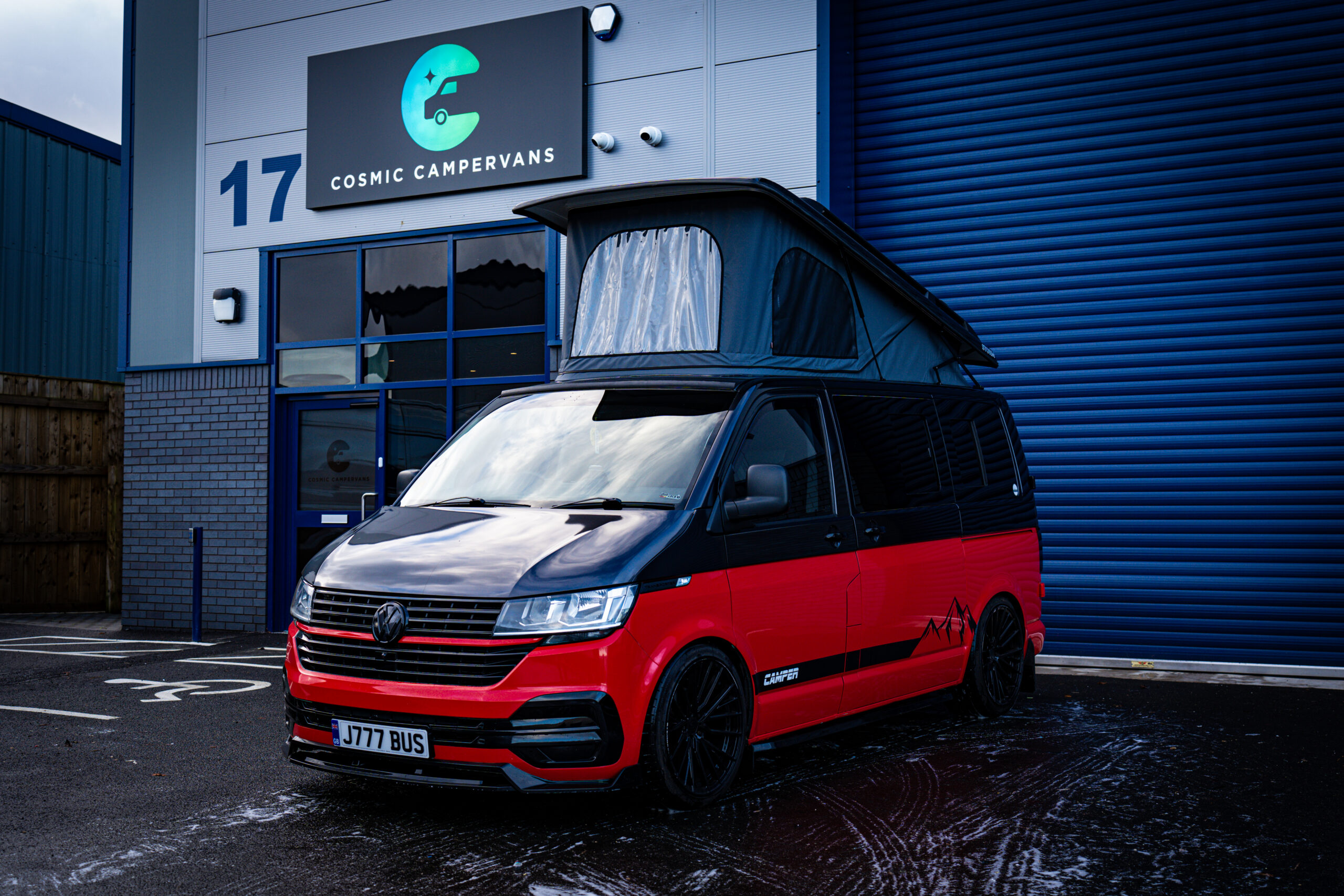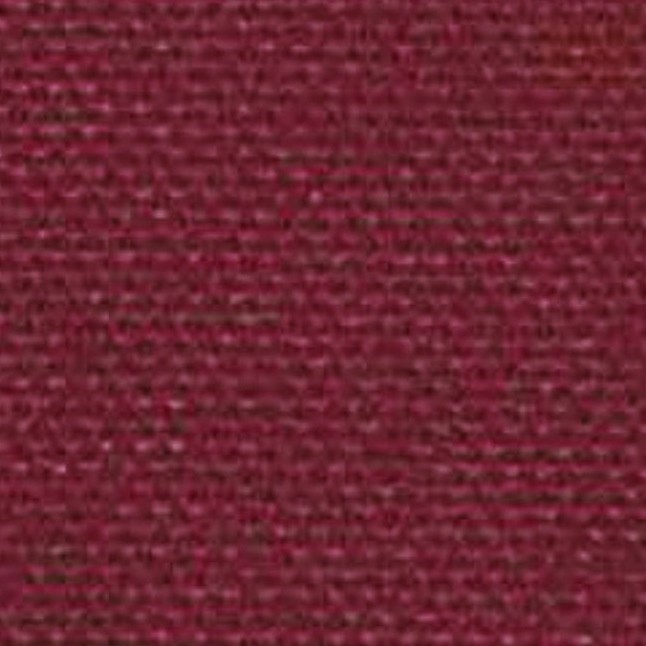Ford Transit Custom vs VW Transporter
A Campervan Converter’s Perspective To Which Van Is Best
Probably one of the most popular questions of 2025, and likely 2026 at this rate. What should I choose, a Ford Transit Custom or a VW Transporter?
Everyone wants to know which is best and I agree it’s extremely important at this stage because this is what you will be with for a large portion of your van life.
I know it can seem quite stressful, but don’t worry. Both of these models are extremely popular and very common. This means there is a lot of support on these models and also lots of guides to help you not make mistakes others have done in the past.
And that’s where I am trying to help as well. I’m going to break down which of these models are going to be better suited for you and your van lifestyle. So, let’s crack this open and get stuck in.
How Much Space Do You Really Get Inside and Out?
Comparison between the space and sizing of VW Transporter & Ford Transit Custom:
The Transit Custom and VW Transporter are very close in overall size, but there are subtle differences that affect camper layouts.
The Transit Custom comes in two lengths: SWB (L1) at ~4.97 m and LWB (L2) at ~5.34 m long. The Transporter likewise offers SWB (about 5.05 m) and LWB (about 5.45 m) versions.
In practice, both LWB variants give around 2.9–3.0 m of usable floor length in the cargo area enough for a basic kitchenette, a bed, and some storage.
The extra ~30 cm of the LWB models is invaluable for more spacious layouts or to fit a fixed bed. Both vans also feature clever load-through hatches that allow inserting very long items under the front seats (a bonus if you need to haul surfboards or lumber inside).
Which of these models has the larger interior?
The width inside the cargo area is a big consideration, especially if you hope to sleep sideways. The Transit Custom’s maximum interior width is about 1775 mm, and between the wheel arches it’s 1351 mm.
The Transporter is almost identical, about 1777 mm max width, and 1392 mm between the wheel wells. Notably, the Transporter’s slightly greater wheel-arch gap (~4 cm more) can make it easier to fit certain modular furniture or wider drawer units on the floor.
Both vans can fit a standard 1200×800 mm Euro pallet between the arches with room to spare, so typical cabinets and beds (often ~600 mm wide each) are feasible on either side.
In short: the VW Transporter has a slight advantage for width at floor level, especially for sideways sleeping or floor-mounted units, but the difference is marginal.
Ford Transit Custom has better height and standing room compared to VW Transporter
Neither the Transit Custom nor the Transporter has full standing height in the standard roof versions. For weekend trips this low roof is manageable (you’ll be sitting or outside most of the time), but for full-time vanlife, the ability to stand becomes important for comfort.
Where the Ford Transit Custom pulls ahead, is if you opt for the high-roof (H2) version, which offers around 1.78 m of internal height, enough for most people to stand comfortably.
The VW Transporter, on the other hand, doesn’t come with a factory high-roof camper option, so standing room typically relies on adding a pop-top.
Comparing the exterior height of these vans & parking options
Externally, both vans (in low-roof form) are around ~2.0 m tall, which is low enough to get under many carpark height barriers (a big plus if you plan to use it as a daily driver in the city).
The Transporter with a pop-top (closed) also stays around 2.0–2.1 m depending on the conversion. In width, both are around ~2.0 m (without mirrors), and about 2.27 m with mirrors out, easy enough for typical roads and driveways.
In short, for everyday drivability, both vans remain relatively compact, and many vanlifers appreciate that these mid-size vans are far easier to maneuver and park than the larger Sprinters/Ducatos.
Which of these vans offer the best interior layout flexibility?
In my experience, the slightly larger volume of the Transit Custom LWB H2 can allow creative layouts that would be tighter in a Transporter.
For instance, I’ve managed to fit a compact enclosed toilet in a Transit Custom L2H2 build (something usually only seen in bigger vans) by using the extra headroom and a smart floor plan.
If you plan a very minimalist weekend camper (just a bed platform and some gear), both vans have plenty of room. But if you envision full cabinetry, fridge, water tanks, and other amenities, the Transit’s extra cubic meter or two can make a difference in how open the interior feels.
That said, thousands of brilliant VW Transporter camper layouts exist and the community has really optimised use of every inch over the years.
Organise a Bespoke Ford Transit Conversion
Upgrade your van with all the comforts of home – kitchen, bedding & more.
What Engine and Drivetrain Setups Do You Get With These Vans?
Which engine option is best for campervan life?
Both Ford and VW equip these vans with efficient 4-cylinder turbo-diesel engines – the workhorses of campervans. The Ford Transit Custom traditionally uses a 2.0L EcoBlue TDCi diesel available in outputs of roughly 105 hp, 130 hp, 170 hp, and later up to 185 hp on high-end trims.
The VW Transporter T6.1 (the 2016–2023 generation common in recent conversions) also uses a 2.0L TDI diesel, with a wider span of tunes from about 90 hp up to 199 hp. In practice, most camper conversions use the mid-range engines: e.g. Ford’s 130 hp or 170 hp, and VW’s 150 hp (which is known as a sweet spot between power and efficiency).
Do you really need front-wheel drive or AWD in a camper?
A key difference is how each van puts power to the ground. The Ford Transit Custom is front-wheel drive (FWD) only – all factory models drive the front wheels.
This layout is common in medium vans for weight and space efficiency. The VW Transporter is also primarily FWD, but critically it offers optional all-wheel drive (AWD) on many variants (Volkswagen calls it 4Motion).
For camper builders, this can be a deciding factor: if you plan to venture off the beaten path, snowy mountains, muddy festivals, mild off-roading… the Transporter 4Motion provides extra traction that the Transit Custom can’t match out-of-the-box.
Manual or auto, which one drives better in a campervan?
Both vans offer 6-speed manual or automatic gearboxes. The Transit Custom’s auto is a conventional 6-speed torque converter, while VW uses its 7-speed DSG dual-clutch auto.
In my experience, Ford’s automatic is smooth and great for easy driving, whereas the VW DSG is quicker shifting but can be jerkier at low speeds.
Which van feels better to drive fully loaded?
Driving empty, a Transporter with the 199 hp bi-turbo diesel feels sporty… some owners even drag-race them! But once built out with a half-ton of camper interior, straight-line speed is less important than reliability and torque.
Both vans cruise comfortably at 100–110 km/h (62–68 mph) on the motorway.
Overall though, both the Ford and VW diesels are proven, efficient engines well-suited to camper life. The choice may boil down to variety vs simplicity: VW offers a broader range of outputs and AWD, whereas Ford keeps it straightforward with a few trims but focuses on efficiency.
Want to Make Van Camping Easier?
Upgrade your VW Transporter with plumbing, carpeting and heating.
Which Van’s Easier to Maintain and Keep Running Smoothly?
When you’re living on the road (or even just far from home on holiday), reliability and ease of repairs are crucial. Both Ford and Volkswagen have strong reputations in the commercial van world, but there are differences in real-world maintenance, build quality, and service networks that I’ve observed.
Which van feels more solid and built to last?
The VW Transporter has long been praised for its solid build – doors that “clunk” satisfyingly, interior fittings that feel durable, and a general sense of robust construction. Many owners describe it as having a more “car-like” refinement and fewer rattles over time.
In my workshop, I’ve seen 10-year-old Transporters that have held up extremely well, both mechanically and in the camper interior (partly thanks to the base van’s solidity).
The Ford Transit Custom, especially the first generation (2013-2023), offers great value but some aspects of its build are a bit less refined – for example, interior plastics that are more prone to scuffs or flimsy feeling panels.
I recall one client’s Transit Custom where the sliding door needed adjustment after a couple of years as the latch got misaligned (a minor issue, but something I see less often on T6s).
Which van can you rely on for the long haul?
Mechanically, the diesel engines in both vans are quite reliable if maintained. VW’s TDI engines have a long service life; there are Transporters with 300,000+ km still going strong.
The Ford EcoBlue engines are newer but also proving durable; and if anything, they are a bit simpler (single turbo, no fancy bi-turbo on most models, etc.).
Each has known weak points: for example, VW’s timing belt on the TDI must be changed every ~200,000 km or 5 years (and yes, it’s an expensive service), whereas Ford’s EcoBlue uses a wet belt design inside the engine that also needs periodic change – both are just maintenance tasks to budget for.
In summary?
For a full-time traveler, the peace of mind of Ford’s widespread service centers is reassuring, but so is VW’s track record of high-mileage longevity.
I’d call it a draw overall: maintain either properly and they’ll serve you faithfully. If you plan on keeping the van for a long time or doing a lot of miles, the Transporter’s “robust feel” and long-term parts support (VW tends to support parts for decades) might be worth the premium. If you’re more budget-conscious and just need a reliable rig for a few great years on the road, the Ford won’t let you down either.
Which Has Better Driving Comfort and Less Noise?
If you’re spending hours behind the wheel chasing horizons, the van’s driving comfort matters. Here’s how the Transit Custom vs Transporter compare in terms of ride, handling, and noise, from my perspective (and feedback from clients who rack up the kilometers).
What’s it like behind the wheel of these vans all day?
Both vans offer a car-like driving experience, especially compared to larger vans. You sit up high but not too far from the windshield. The Transit Custom’s cab is very well thought-out – Ford poured a lot of their passenger car know-how into it.
The seats are supportive, there are plenty of storage cubbies, and even legendary cup holders (Transit’s dash has deep cup holders that fit a big coffee – small thing, but on a long drive I love this).
The steering wheel and pedals have a nice alignment; I find I can drive a Transit Custom all day without backache.
The VW Transporter’s cabin is also excellent, but in a slightly different way. Especially in higher trims, the Transporter feels like an SUV – you might get plush Alcantara/leather seats, a slick dashboard, and even a fully digital cockpit on the latest models.
It’s a bit more of a “premium lounge” vibe, whereas the Ford is a “practical cockpit.” That said, some reviewers (and I agree) note that the Transporter’s fancy interior features don’t always add functionality for a working van.
Which of the VW Transporter or Ford Transit Custom is smoother on the road?
The VW Transporter has a very refined ride quality. It uses a combination of independent front suspension and a well-tuned rear suspension that soaks up bumps nicely.
On the motorway, Transporters feel stable and quiet, one of my clients described his T6 camper as “it rides like a car on long trips” and indeed it’s easy to forget you’re in a van.
The Transit Custom’s ride is also good. Ford really dialed in the chassis to be agile and responsive. I personally find the Transit handles more sharply (less body roll in corners), which might be the result of its suspension setup.
However, the Transit can ride a tad stiffer when empty. Once you build it out with a camper interior, the weight actually makes the ride smoother. The new 2024 Transit Custom apparently has an even more advanced suspension design that Ford claims gives a “quieter, smoother driving” experience.
In any case, both vans are comfortable for long drives, but if I had to pick: the Transporter has a slight edge in ride plushness, while the Transit feels a bit more nimble and “connected” to drive.
Which van gives you a quieter drive?
Here’s an interesting observation: the Ford’s EcoBlue diesel is surprisingly quiet from inside the cab. Ford put effort into sound insulation and engine refinement – at idle and low speeds, the Transit Custom’s diesel is muted, and at highway speeds the wind noise is more noticeable than the engine.
The VW TDI engines are a bit louder, especially older ones (that characteristic diesel grumble is more present). The Transporter’s engine noise is by no means bad – and in the latest Euro 6 versions it’s well damped – but side by side, my personal experience is the Transit is quieter under acceleration, whereas the VW’s engine note is audible (some actually like hearing the engine).
How easy are they to park and manoeuvre?
Both vans offer modern driver aids. You can get adaptive cruise control, lane-keeping assist, parking sensors, rear camera, etc. The Transporter, in higher trims, even offers things like auto emergency braking.
The Transit Custom has had options for blind-spot monitoring and a clever mirror system. In practice, I value visibility the most: both have large windows in the cab and good mirror coverage. I slightly prefer the Transit’s mirror design – it gives a great wide-angle view down the side which is helpful on highways.
How comfortable are these vans in hot or cold weather?
Minor point, but worth mentioning: the Ford’s cab heater is excellent (heats up fast, with an optional heated windshield that’s a godsend on cold mornings), and the AC is strong.
The VW’s climate control is more sophisticated if you get Climatronic (dual-zone, etc.), but functionally both keep you comfortable. In camper use, many add auxiliary heaters; diesel parking heaters integrate similarly in both vans, tapping the fuel tank – no major difference there.
Which van is more comfy to drive for long road trips?
I’ve done a fair few road trips in both. The seat comfort is subjective, but I found the Transit Custom’s seats to be a bit softer and more “armchair-like,” while the VW’s (at least in the ones I’ve driven) were firmer and more contoured.
After 8 hours of driving, I actually felt a little less fatigue in the Ford – could be personal preference or just that particular trim.
In summary, both vans deliver a high level of driving comfort for a campervan – leagues better than the truck-like vans of old. The Transit Custom feels more like driving a modern SUV or MPV, with a very ergonomic cabin and low noise, whereas the Transporter feels like a premium European car with a supple ride and high-end tech touches.
Which Van Is Better For Fuel Economy & Trips
With fuel prices always a factor (especially for full-time travelers covering lots of distance), fuel economy can be a deciding point. Also, if you’re environmentally conscious or travel in emissions-regulated areas, engine efficiency and emissions tech matter.
VW Transporter vs Transit Custom on diesel fuel efficiency…
When it comes to fuel efficiency, both the Ford Transit Custom and the VW Transporter hold their own, especially when you’re starting with a clean slate.
On paper, both can reach 36–44 mpg, but once you build them out into fully kitted campervans, with the added weight of cabinetry, pop tops, and roof racks, those numbers start to drop into the high 20s to low 30s.
From what I’ve seen in the conversions I’ve done for clients, a VW Transporter T6 with a high roof and all the extras still managed to average around 35 mpg (UK) over long distances.
That’s solid, especially for something with full living amenities. On the Transit Custom, I’ve helped clients set up builds that regularly get around 30–34 mpg (UK) on a mix of motorway and backroad trips.
One thing I’ve noticed with the Transit Custom’s EcoBlue engine is that it performs slightly better at idle and around town compared to the VW. It’s not a night-and-day difference, but it’s noticeable when you’re crawling through city traffic or sat still at a campsite.
So yeah, if you’re trying to choose between these two from an efficiency standpoint, you won’t go wrong with either—but if you’re doing a lot of city driving, the Transit might just edge it.
What Is The Support Like For These Vans?
One area where these vans really diverge is in the aftermarket support and community for camper conversions. As a converter, this affects everything from part availability to the design possibilities we can offer clients.
Is the VW Transporter still the king of camper conversion support?
The VW Transporter is a top choice for camper conversions thanks to its huge aftermarket support. You can get pre-cut kits, flat-pack furniture, insulation, pop-tops, and even swivel seats all made to fit perfectly… especially for the T5 and T6 models.
There’s also a big network of pro converters who specialise in Transporters. Whether you’re DIY’ing or going pro, it’s one of the easiest vans to build out, and the vanlife community around it is massive, so you’ll never be short on ideas or support.
How much support is out there for converting a Transit Custom?
The Ford Transit Custom is quickly catching up in the camper world. While it started off more as a work van, it’s now a popular base for camper conversions, especially since 2013.
You’ll find poptop roofs, swivel seats, and bed frames made to fit, and more companies are jumping on board with Transit-specific gear.
That said, ready-made furniture kits aren’t as common as with the VW Transporter. In my shop, we cut custom cabinets for the Transit’s shape because the options just aren’t as plug-and-play.
But here’s the upside, the Transit’s straighter walls and boxier layout actually make it easier to build inside. So if you’re after a clean, tailored fit, it’s a great “blank canvas.”
What’s the best van layout to start with?
Both the VW Transporter and Ford Transit Custom come in different setups, Panel Van, Kombi, and full Shuttle/Caravelle styles. From my experience, the Panel Van is usually the best starting point. It gives you a blank canvas…no factory windows, no insulation, so you can place everything exactly where you want it.
That said, if you need rear seats for everyday use, both vans have flexible options. The Transit Custom Kombi has removable seats, and I’ve worked on the Double Cab in Van (DCIV) version too.
In one build, we ripped out the rear seats and bulkhead to open the space back up, worked really well. Just watch for those fixed bulkheads, they can block off your walkthrough unless you remove them.
The Transporter Kombi also has quick-release bench seats, which is handy if you want to switch between camper and people carrier.
So yeah…go Panel Van if you’re starting from scratch. If you’re juggling family use and camping, a Kombi works, but be ready to customise a bit to make it feel like a proper camper.
Kombi Conversions Made Easy
Convert your van into a 6-seater Kombi with our professional conversions.
How easy is the conversion of both vans?
From a builder’s point of view, the Transit Custom is honestly a joy to convert. The wiring is simple, there are ready-made grommets for cabling, and the body panels are easy to cut it feels like Ford designed it with converters in mind. I’ve done loads of these, and they’re always straightforward to work on.
The VW Transporter, on the other hand, has the edge when it comes to community knowledge and parts support. I’ve fitted T30 springs to a T28 before with no issues, thanks to how well-documented VW conversions are.
So if you want an easier physical build, go Ford. If you want endless resources and plug-and-play upgrades, VW’s got the lead there.
Comparing The Ford Transit Custom vs VW Transporter
| Feature | Ford Transit Custom | VW Transporter |
| Length (SWB / LWB) | 4.97m / 5.34m – Compact, great for cities. | 5.05m / 5.45m – Slightly longer, more floor space. |
| Height (Low / High Roof) | H1 ~2.0m / H2 ~2.4m – H2 offers stand-up space. | ~1.98m standard – Needs a pop-top for headroom. |
| Interior Height | H1: no standing. H2: ~1778mm – comfy upright space. | Standard: no standing. Pop-top gives full standing room. |
| Interior Width | 1351mm between arches – squarer, easier for cabinets. | 1392mm between arches – a bit wider, good for sideways beds. |
| Engine Options | Diesel (105–185hp), PHEV hybrid, full electric. | Diesel (90–199hp). No hybrid. EV is separate platform (ID.Buzz). |
| Drivetrain | FWD only – no 4×4 version. | FWD or AWD (4Motion) – ideal for off-road/adventures. |
| Transmission | 6-speed manual or auto – smooth for city use. | Manual or 7-speed DSG – fast shifts, needs upkeep. |
| Fuel Economy (Diesel) | ~30–35 mpg real-world once converted – efficient. | ~30–35 mpg average – similar to Ford; higher engines use more. |
| Payload Capacity | ~700–1400kg – strong payload, handles full fit-outs. | ~800–1300kg – T32 ideal for heavier builds. |
| Driving Comfort | Car-like feel, agile handling, simple cabin layout. | Smoother long-distance ride, more refined interior and options. |
| Reliability & Servicing | Easy to fix, parts are cheap, widely available. | Built to last, longer service intervals, but pricier maintenance. |
| Conversion Support | Growing range of camper parts. More custom work needed. | Huge aftermarket support. Loads of plug-and-play kits. |
| Vanlife Community | Practical and low-key. Increasing popularity. | Iconic – huge community, meets, and enthusiast culture. |
| Resale Value | Lower upfront cost. Depreciates quicker. | High resale demand. Retains value very well. |
So, Which Van Do I Recommend Then?
After converting countless Transit Customs and Transporters over the years, I’ve learned one thing for sure…there’s no one perfect van.
The best choice depends entirely on how you’ll use it. So which is right for you?
Will you be using your van on the weekends or for occasional road trips?
If your van is mainly for weekend getaways, a few holidays a year, or the odd surf trip, I’d lean toward the Ford Transit Custom.
You’ll get more features for your money and newer van, lower mileage, better spec. I’ve converted plenty of Customs that doubled as a daily driver and weekend camper.
They’re easy to drive, feel a lot like a large family car, and come with handy features like a heated windscreen and automatic gearbox (perfect for winter camping or early starts).
Plus, the interior space is great for short trips. You won’t feel cramped, and if you go for a Kombi version, you can still use it for work or family during the week.
Are you a full time vanlifer or planning long term travel (6+ months)?
If you’re planning to live in your van, or spend months travelling, this is where the VW Transporter starts to pull ahead.
The Transporter’s build quality, proven reliability, and resale value make it ideal for long hauls. I’ve built full-time setups in T30 and T32 models that handled heavy mileage without breaking a sweat.
You’ll find dedicated VW service centres and specialists almost everywhere in Europe, and the community support is massive with forums, guides, events, everything. If you’re going off-grid or hitting the backroads, a 4Motion AWD Transporter is hard to beat.
That said, don’t write off the Transit Custom LWB High Roof. I’ve built a few for long-term travellers, and the full standing height is an absolute game changer.
So if you want long-term reliability and resale, go VW. If space and comfort on a budget matter more, the Transit Custom H2 is seriously worth considering.
DIY Builders vs. Professional Conversions
Are you building it yourself or hiring a professional?
If you’re building your camper yourself, the VW Transporter wins hands down for convenience.
On the other hand, if you’re hiring a professional converter (like myself), both vans are fair game.
Some of the best conversions I’ve done have been on Transit Customs. You save money on the base van, which means you can upgrade things that really matter like a bigger fridge, better heater, or higher-end finishes.
Are you going to be taking your campervan off-grid or into adventures?
If you’re dreaming of rugged trails, snow, or sandy tracks, you’ll want a VW Transporter 4Motion. I’ve built and tested them; they can go places a front-wheel-drive Transit Custom simply can’t.
You can tweak the Transit with better tyres or suspension, but it’s still FWD at heart. If true off-road capability is part of your plan, VW is the way to go.
Final Thoughts:
At the end of the day, choosing between the Transit Custom and the VW Transporter really comes down to what matters most to you. It’s a bit like the old debate between practicality and prestige.
The Transit Custom is an absolute workhorse, spacious, functional, and brilliant value for money. I often recommend it to clients who are building on a budget or want to get the most comfort and function for their spend. It’s a van that lets you put more money into the bits that make the journey better like insulation, a good electrical setup, or a clever layout.
The VW Transporter, on the other hand, is the classic. It’s refined, holds its value well, and has that iconic campervan vibe. If someone tells me they want something they can full-time in for years, then sell on with confidence it’s hard not to lean towards the VW. There’s a reason it’s been a go-to for vanlifers for decades.
So think about what’s important to you. Budget, space, driving feel, or brand… and go from there. And hey, if you’re still unsure, just reach out. I’m always happy to help you figure it out. Happy travels, and enjoy the ride!



